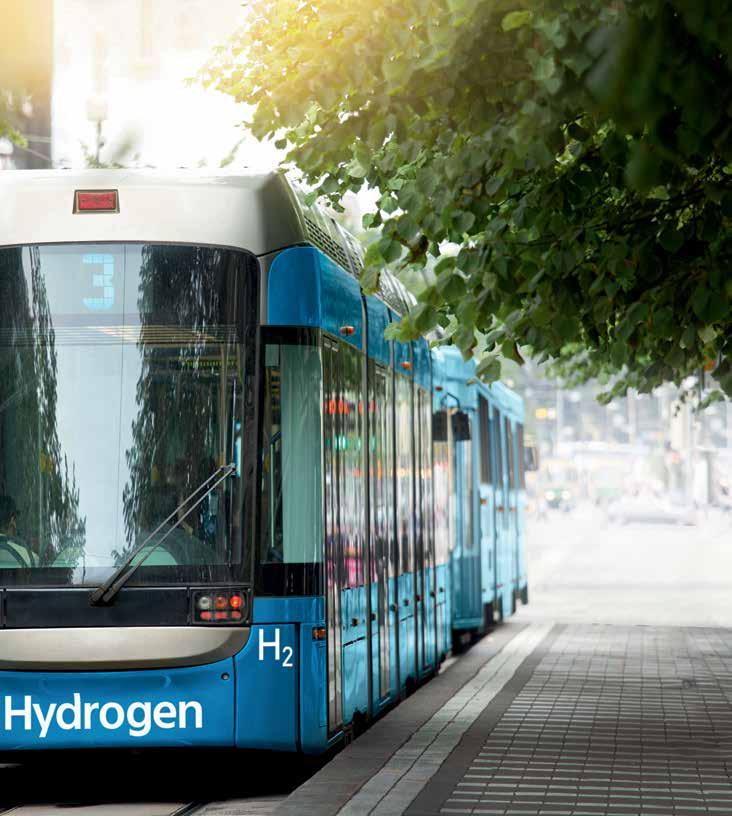
For daily news visit us at wbj.pl Since 1994 Poland’s leading business magazine in English WARSAW BUSINESS JOURNAL APRIL - MAY 2023 ~ No. 2 (77) CEEQA REPORT: HOW ESG IS CHANGING THE BUSINESS LANDSCAPE Towarowa Towers and Square Investments Without Compromise Developed by Asbud Group Karimpol announces: second phase of SKYLINER complex begins Navigating Industry 5.0: Insights from ifm electronic CEO Aleksandra Banaś Visit us online STEP ONBOARD THE HYDROGEN REVOLUTION




8 In Review
News
14 Opinion
Polish banks and Remote working by Sergiusz Prokurat
19
Lokale Immobilia
Exclusive: Karimpol Group Skyliner
Five Questions for Hadley Dean
Event Report: MIPIM by Morten Lindholm
Towarowa Towers and Towarowa Square developed by Asbud Group
29 Investing in Poland
Hydrogen Valleys by Beata Socha
Investing Insights

Interview: Łukasz Grabowski, PAIH
40 Features
Europe's Military Powerhouse by Sean Reynaud

Poland and South Korea by Sean Reynaud
Interim Management in a Family Business by Dr. Katarzyna Sobańska-Helman

51 Tech
Metaverse by Sean Reynaud
Interview: Aleksandra Banaś, CEO of ifm electronic
Opinion: by Beata Socha
Opinion: by Jacek Krawczak
61 Life + Style

Pani Jurek
Varietal of the Month by Wine
Expert Peter Puławski of dobrawina.pl
64 Events
2 APRIL - MAY 2023 WARSAW BUSINESS JOURNAL APR/MAY
51 58 61 40 14 ALL IMAGES SHUTTERSTOCK EXCEPT TOP LEFT BY PION STUDIO




PUBLISHER'S NOTE
WHERE WE ARE NOW –THE STATE OF THE POLISH ECONOMY AFTER Q1 2023
The Polish economy faces a mixed outlook for the rest of the year and onwards, with various positive and negative trends emerging. While there are expectations of GDP growth in 2023 and 2024, real wage growth may only occur at the end of 2023 or early 2024 due to rapid price increases for goods and services.
According to data from the Central Statistical Office (GUS), inflation on goods and services in March was at a high of 16.2%. However, it is expected to decrease to 9% by the end of 2023.
One of the factors that could contribute to a slower decrease in inflation is the expected rise in fuel and oil prices following the announcement slashes in production by OPEC+ at the end of March. This could impact the cost of living in Poland, particularly in terms of transportation costs.
Despite these challenges, there are positive developments on the horizon for Poland's economy. For example, the country is not expected to enter a recession in 2023. Some experts are even forecasting GDP growth of 0.7-0.8% for the year and a much better outlook in 2024 with increases of 2.7-2.8%.
Ukrainian President Volodymyr Zelensky’s recent visit to Warsaw resulted in the signing of an agreement for cooperation in the reconstruction of Ukraine. Poland has over 100 companies ready to help with rebuilding, which could lead to new business opportunities and trade relationships between the two countries.
On the other hand, the outlook for job seekers in Poland may be less optimistic. While the unemployment rate was 5.4% in March, a significant difference from the 30-year low of 2.9% in 2022, the job posting portal Pracuj.pl has confirmed seeing fewer job postings in 2023 than in the previous year. This suggests the labor market may be experiencing a slowdown, which could impact the country's overall economic growth.
Finally, while Polish export numbers for 2022 were very positive, with a growth rate of 21.6%, expectations for coming years are less impressive, with growth rates of 14.5% in 2023 and 12.6% in 2024. These lower rates could be due to a combination of factors, such as global economic trends, changes in trade policies, and supply chain disruptions.
Times are still challenging, and predictions and forecasts are uncertain, but it could be much worse, so let's stay positive as we head into what should be three interesting months before the summer slows us down. Enjoy our collection of insights and behind-the-scenes stories about Poland and Polish businesses.
Have a great read and a productive spring business season!
MORTEN LINDHOLM

4 APRIL - MAY 2023 WARSAW BUSINESS JOURNAL PORTRAIT BY KEVIN DEMARIA
24-26 April 2023 —

International Congress Centre in Katowice
XV EUROPEAN ECONOMIC CONGRESS
The biggest business event i n C entral E urope


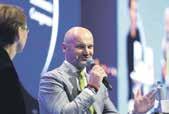

Key topics:
Green Economic Transformation | Technologies, innovations, digitisation | EU funds – tapping the potential| Real estate market | ESG – requirements and str ategies

WWW.EECPOLAND.EU REGISTER NOW
GUESTS THIS ISSUE
Łukasz Grabowski
A graduate from the Warsaw School of Economics. He is a winner of the Deutscher Akademischer Austauschdienst scholarship at the Johannes Gutenberg University in Mainz, Germany. He has gained professional experience working at the Polish Oil and Gas Company, Deutsche Bank headquarters in Frankfurt am Main, the PwC Office in Warsaw, the Embassy of the Kingdom of Norway in Warsaw and STTAS, a UPS company, an advisory and consulting company in the area of international trade. He has been working for PAIH since 2019.
Interview on page 32
Deputy Mayor of Krakow, responsible for Sustainable Development. He has a background in law, having worked in the insurance industry from 1991 to 2003. In 2003, he joined the City Hall of Krakow as the Director of the Architecture and Urban Planning Department. Following this, he ran his own legal counsel practice from 2006 until 2018.
Interview on page 36
CONTRIBUTORS
Beata Socha
Journalist, editor, writer, blogger. During her seven-year stint as Warsaw Business Journal’s Managing Editor, Beata covered a number of beats, from public policy, economy and real estate, through to technology and society. She blogs about cloud computing and fiction writing, the rise of AI and the future of the job market. Economist and linguist by education.
Sean Reynaud
A former U.S. Air Force Signals Intelligence Analyst, with a degree in Computer Information Systems, History and Communications. Having spent 20 years overseas, including Japan, South Korea and Kosovo, he now lives and works in Poland. As a WBJ contributor, Sean covers geopolitics and global economy, green initiatives and technologies.
Morten Lindholm
Editor-in-Chief/Publisher mlindholm@valkea.com

Kevin Demaria Art Director kdemaria@valkea.com
Jessica Sirotin
Editor
Krzysztof Maciejewski Business & Web Editor kmaciejewski@wbj.com
Contributors
Nikodem Chinowski
Sergiusz Prokurat
Sean Reynaud
Beata Socha

Alex Webber
Sales Izabela Kaysiewicz ikaysiewicz@valkea.com
Katarzyna Pomierna kpomierna@valkea.com
Print & Distribution
Krzysztof Wiliński dystrybucja@valkea.com

Event Director, Valkea Events Magda Gajewska mgajewska@valkea.com
Contact:
phone: +48 22 257 75 00 fax: +48 22 257 75 99 e-mail: wbj@wbj.pl WBJ.pl
For enquiries,subscriptions-related
please email us at wbj@wbj.pl
WarsawBusinessJournal @wbjpl

All photographs used in this issue are courtesy of partners and companies unless specified otherwise.
Copyright © 2023 by Valkea Media SA
All rights reserved. This publication or any portion thereof may not be reproduced or used in any manner whatsoever without the express written permission of the publisher.
Published by ul. Jerzego Ficowskiego 15 Valkea
6 APRIL - MAY 2023 WARSAW BUSINESS JOURNAL
Media S.A.01-747 Warszawa Tomasz Opiela, CEONIP: 525-21-77-350 www.valkea.com To subscribe through RUCH SA: www.prenumerata.ruch.com.pl, prenumerata@ruch.com.pl, 801 800 803
Jerzy Muzyk
DEGROWTH AS THE NEW NORMAL – PERSPECTIVES AND OPPORTUNITIES
19-21 of May 2023
THEMATIC WORKSHOPS


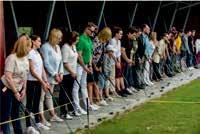




DISCUSSION PANELS
FAMILY PICNIC
GAL A DINNER AND CHARIT Y AUCTION
Register at: www.kongresmba.uek.krakow.pl
IN REVIEW
GERMAN TOURISTS RETURN TO POLAND
Around 2.8 million German tourists visited Poland in 2022, almost 47% more than in 2021. This is roughly the same number as before the outbreak of the coronavirus pandemic. Poland ranks eighth among the favorite foreign travel destinations for German citizens. They spent €1.7 billion in Poland last year.

8 APRIL - MAY 2023 WARSAW BUSINESS JOURNAL
SHUTTERSTOCK
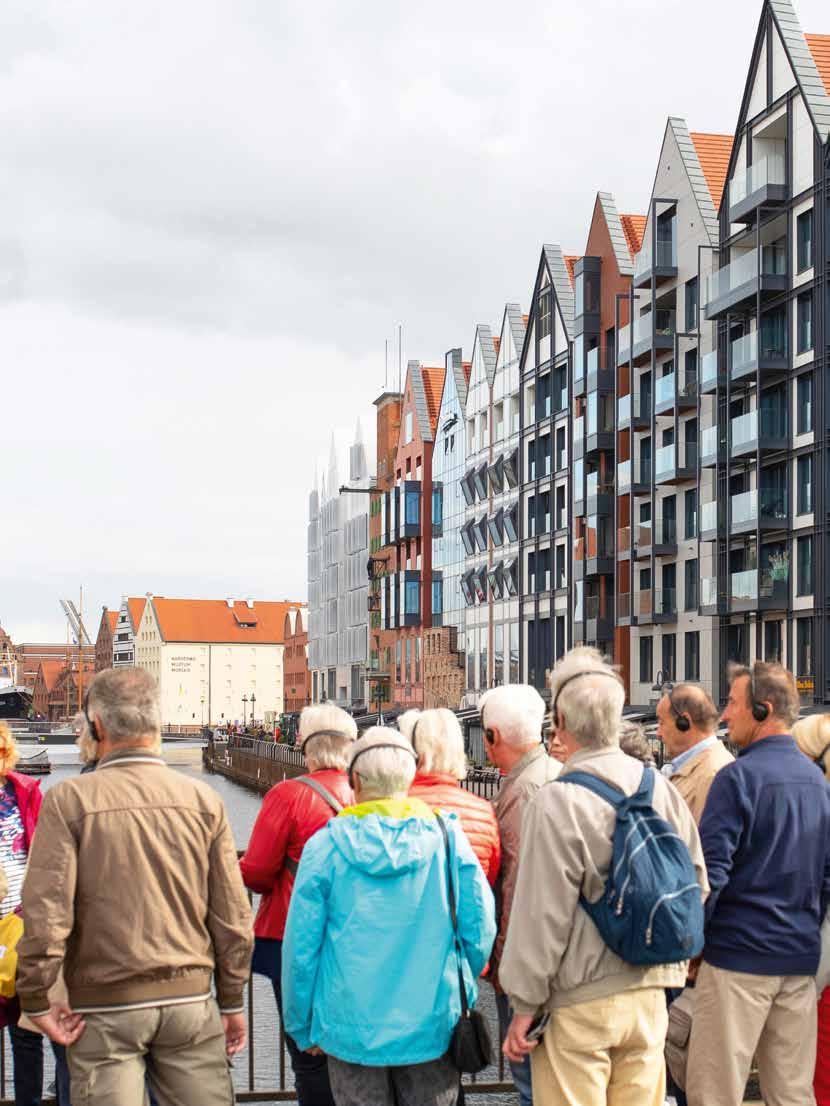
EXPORTS
Door and window exports up 32% in 2022
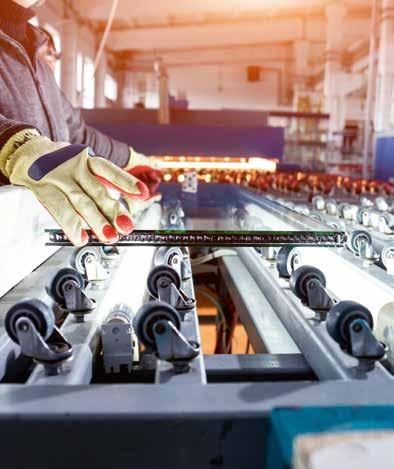
The export of windows and doors from Poland increased by 32% in 2022, reaching €3.96 billion compared to €2.98 billion in 2021, according to the Center for Industry Analysis (CAB). Polish companies sell more than twice as much as German producers on foreign markets. Since 2004, Polish carpentry exports have increased more than twelve-fold, and in 2022, 31% of the value of exports of all EU countries was from Polish firms.
QUOTE: Volodymyr Zelensky
He quoted Polish writer Jerzy Giedroyc who had said that
EXPORTS
Polish exports keep growing
Polish exports to Germany increased by 8.2% y/y to €7.6 billion in January 2023, while imports in the same period increased by 0.4% y/y to €5.5 billion, according to GUS data. Germany’s share in Polish exports decreased by 0.7 percentage points to 27.2%, while in imports, it fell by 0.8 percentage points to 20.6%.
The positive balance amounted to PLN 10.1 billion (€2.2 billion) compared to PLN 7.5 billion in the same period in 2022.
The largest turnover in imports was recorded with developed countries –PLN 94.6 billion, including PLN 84.6 billion with the EU, compared to PLN 84.1 billion (PLN 77.9 billion with the EU), in the same period of 2022.
ENERGY
EC grants €124 mln to gas pipeline construction in Poland
The European Commission has approved the transfer of more than €124 million from the European Regional Development Fund for the construction of a 253-kilometer section of gas transmission pipeline in the Mazowieckie, Łódzkie and Lubelskie regions.
These are funds from the 2014-2020 programming period. This section is part of over 300 km of gas pipeline from
Ukrainian President, Volodymyr Zelensky, held his first official diplomatic visit to Poland on on April 5-6 , during which he talked to PM Mateusz Morawiecki and made a joint appearance with President Andrzej Duda.
10 APRIL - MAY 2023 WARSAW BUSINESS JOURNAL
News
“there is no independent Poland without an independent Ukraine”, “And I would continue. Russia cannot prevail over Europe when a Ukrainian and a Pole stand shoulder to shoulder”
SHUTTERSTOCK (2)
IN REVIEW
Gustorzyn to Wronów. “This project is a concrete example of cohesion policy support for energy security in Europe. It will significantly contribute to Polish energy security by diversifying gas supply sources and will enable gas exports to Lithuania, Slovakia and Ukraine,” said Commissioner for Cohesion and Reforms, Elisa Ferreira.
PGE plans 6.5 GW of offshore power by 2040
Polish energy company Polska Grupa Energetyczna (PGE) aims to achieve 6.5 GW of installed capacity in offshore wind farms by 2040. The investment program will be funded both from Polish and international sources. In 2022, PGE’s investments amounted to PLN 6.7 billion, nearly PLN 2 billion higher than the previous year. PGE generates 41% of net electricity in Poland and has a 10% share in renewable energy.
INTERNATIONAL Half of Polish firms employ Ukrainian citizens
The number of Ukrainian workers in large companies is increasing, with almost every other employer now having a worker from Ukraine, up 7 percentage points compared to November 2022 and 15 percentage points up y/y.
The majority of Ukrainian workers (58%) are employed in companies with over 250 employees. Almost one-third of Ukrainian workers are employed as skilled mid-level staff, which is a 4 percentage point increase from the previous survey.
DOMESTIC New technological lines for ammunition production planned
Poland plans to launch new technological lines for ammunition production, Prime Minister Mateusz Morawiecki announced, stressing that production should start as quickly as possible. The PM also pointed to possible EU funding sources for ammunition manufacturing, as well as expressed hope for private sector initiatives.
Minumum Wage Around The World
From January 1, 2023, the minimum wage in Poland rose to PLN 3,490. It is set to further increase up to PLN 3,600 from July 1 this year, putting it PLN 590 above the minimum wage in 2022, and marking a 19.6% growth year-on-year.
JOB MARKET
Over 70% of Polish firms struggle to find employees
More than 70% of Polish employers have difficulty finding employees with the right skillset, according to ManpowerGroup’s “Talent Deficiency” survey. Companies from the communication industry struggle the most. Globally, the problem with recruiting the right talents is reported by 77% of companies versus 72% in Poland.
Compared to Poland, the situation is better in the Czech Republic (66%) and Slovakia (68%), while in Germany, 86% of the companies struggle to find adequate candidates.
FINANCE WSE trading volume drops 44.1% y/y in March
The total value of trading in shares on
the Warsaw Stock Exchange main market in March amounted to PLN 24.8 billion, 44.1% less than a year ago. The value of the WIG index at the end of March stood at 58,608.76 points and was 9.7% lower than a year earlier. In March, the NewConnect market recorded a decrease in the total value of trading by 36.8% y/y to PLN 201.9 million.
TRANSPORT PKP Intercity with record high passenger traffic in Q1
PKP Intercity carried a record number of passengers in the first quarter of 2023, more than 13.7 million, board member Tomasz Gontarz announced.
“Big news! Q1 2023 was the best in the more than 20-year history of @PKPIntercityPDP! We carried over more than 13.7 million passengers!” Gontarz wrote on Twitter.
WBJ.PL 11
Paraguay $323 Uruguay $424 Chile $369 Ecuador $407 Guatemala $383 U.S. $1,550 Canada $1,545 FRA $1,380 ESP $925 GER $1,584 Australia $1,866 Portugal $690 IRL $1,753 Saudia Arabia $958 Nigeria $68 S. Africa $226 POLAND $584 ROU $393 GRC $626 Turkey $457 UKR $146 CZH $643 BLR $189 EST $704 $1,385+ $645 $345 $205 $0 LVA $555 LTU $646 SVN $896 HRV $571 MNE $459 BIH $324 HUN $383 SVK $572 Russia $224 South Korea $1,333 Philippines $141 INDIA $95 Thailand $195 Hong Kong $959 UK $1,705
Sources: Picodi, U.S. Department of Labor
OPPOSITION PARTIES COULD WIN ELECTIONS, BUT ONLY TOGETHER
Despite being the second-largest party in terms of voter support, Civic Platform's chances of forming a government will largely depend on whom they decide to form a coalition with. Alone, their chances of forming a government are slim.
BY EWA BONIECKA
According to a recent poll by the daily Rzeczpospolita, if all political groupings were to enter the ballot separately, the ruling Law and Justice (PiS) would garner 34.4% of the vote, while Civic Coalition (led by the centrist Civic Platform) would collect 26.6% of the vote. The third spot would go to Confederation (9%), followed by the Left (8.5%). Finally, Poland 2050 and the Polish People's Party would take a mere 7.9% each.
The situation changes significantly if the parties with lesser support run together. A coalition of PSL, Poland 2050, and the "Yes for Poland" movement could get 15.5% of the ballot, throwing the established majorities off balance. In this scenario, the opposition would win 241 seats in the Sejm, allowing them to form a government. But it would require much effort on all sides to create a united front against the ruling party.
Interestingly, as many as 7.3% of Polish voters remain undecided, which presents both a challenge and an opportunity for all involved.

Grzegorz Schetyna: We will fight for society's trust and reach out to the younger generation, and I will continue this fight until the end of the elections. As opposition MPs, we travel across the country, talking to and supporting Ukrainian neighbors in their struggle for freedom and democracy against the Russians. We criticize the PiS government's actions, which have caused tension in Poland due to inflation and price increases, as well as in other European Union countries, to which the PiS government has not responded adequately. Its weak role in foreign policy has exacerbated the situation. Furthermore, tensions exist within PiS, as Zbigniew Ziobro, the Minister of Justice, and his group oppose PiS and promote their own ideas. Although the opposition also has internal divisions, they do not concern critical issues such as aid for Ukraine.
I am confident in our ability to win the elections, but it will require our unity and strength, and I will continue to fight for this until the end. Our local governments are a source of strength, and we must plan for the future, particularly in foreign policy. We must think beyond today and consider our relations with Russia, developing countries, and the future rather than only the present, as the government's foreign minister is barely visible in the European Union. During our future governments, we want to change this situation.
Grzegorz Schetyna, Civic Platform MP and former leader of the political group stepped down when Donald Tusk returned from his Brussels posting as the President of the European Council.

12 APRIL - MAY 2023 WARSAW BUSINESS JOURNAL IN REVIEW Domestic
WBJ asked former Civic Platform leader Grzegorz Schetyna about the Coalition's chances in the 2023 parliamentary election.
SHUTTERSTOCK (2)
Prices on the rise
20.8% retail price growth in February, following increases of 20% in January & 24.8% in December 2022.
(y/y, UCE Research)
18,000
number of companies Ukrainian refugees created in Poland since the outbreak of the war.
(Minister of Family and Social Policy)
…as unemployment holds
5.5%
Poland's registered unemployment rate in February, unchanged compared to the previous month.
(GUS)
Manufacturing slows down…
19 out of 34 sectors recorded a decline in industrial production in February
(GUS)
Growth outlook steady 0.9% is Poland's 2023 economic growth forecast
(S&P Global Ratings)
…as industrial production prices soar
18.4%
is how much industrial production prices increased in February.
(y/y, GUS)
Wages chase inflation…PLN
Saving electricity

1.8%
drop in electricity consumption y/y in February, to 14,050 GWh. In JanuaryFebruary, consumption was 29,138 GWh, down 3.52% y/y
(PSE)
7,065.56
was the average gross salary in the enterprise sector in February, a 13.6% increase y/y.
(GUS)
$411
billion
is how much the World Bank predicts will be needed to rebuild Ukraine, including $14 billion later this year to finance critical and priority investments.
(World Bank)
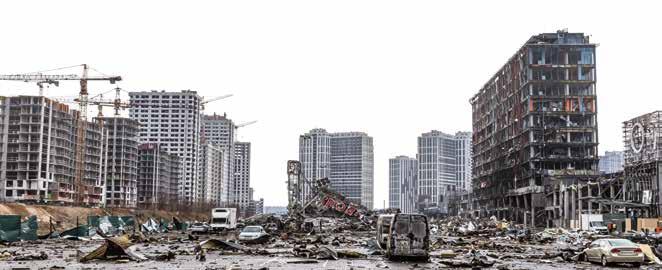
WBJ.PL 13 IN REVIEW News in Numbers
BANKS ARE HAVING PROBLEMS… AGAIN

We are currently witnessing a level of turbulence in the global banking sector not seen since the 2008 financial crisis triggered by the collapse of the American investment bank Lehman Brothers. Now with some US and European banks facing difficulties, uncertainty in the banking sector has returned like a boomerang. Where does this leave Polish banks?
BY SERGIUSZ PROKURAT
we are living in tumultuous times. Information spreads at the speed of light on the internet with unforeseen yet inevitable consequences. Banks that purchased bonds listed on the market became lossmakers following a hike in interest rates. This triggered further consequences as banks began showing a decrease in assets. For instance, at the beginning of 2023, the total market value of the US banking system's assets was approximately $2 trillion lower than the book value of the asset portfolio.
BANKS ARE NOT BANKING ENOUGH
Inflation does not only impact consumers; it also affects enterprises, including banks. Following a long period of low-interest rates, banks were eager to play in the financial markets, but this strategy backfired when it became apparent that they had invested their money in the wrong assets. When a banking crisis arises, it’s like when low tide comes along and you can suddenly see who was swimming without their underpants. Investors inevitably noticed that there was a problem and got scared. The share prices of many banks fell, and, at the beginning of March, a large outflow of deposits began.
As always, the central banks came to the rescue. However, they are heroes with only one superpower. So yet again, we are witnessing an active support program for commercial banks from the Federal Reserve which simply means access to loans. This time it also includes support from the Bank Term Funding Program, under which the Federal Reserve will lend money to banks against treasury securities valued at a nominal price, rather than market price, to ensure adequate liquidity in the markets. Essentially, the Federal Reserve has committed to buying back the proverbial lottery tickets at the amount they were purchased for.
This is only the start and it will likely end with the internationalization of aid across the board. British banks will be able to apply directly to the Bank of England, which will borrow from the Federal
14 APRIL - MAY 2023 WARSAW BUSINESS JOURNAL
SHUTTERSTOCK
OPINION
Reserve as well. It will work the same way for banks based in the Eurozone, Japan, and Switzerland. So in the end $2 trillion will go to the banks.

A SCARY MOVIE FOR POLISH BANKS
The problem of shrinking bank capital as a consequence of, among other things, discounts on government bonds, also applies to Poland, so some banks here should be worried. However, in Poland, banks also carry a heavier burden. Part of it is generated by the government before the elections, which results in things like, e.g. credit holidays – an unconditional temporary option to postpone the repayment of upcoming loan instalments. Additionally, Polish banks are also afraid of court cases regarding mortgage loans denominated in Swiss francs in regards to abusive, defective elements of the loan contracts (especially following the consumersupporting opinion of the CJEU Advocate General).
Another risk is that mortgage loan borrowers in Polish currency are looking for legal options in connection with undermining the Warsaw Interbank Offer Rate (WIBOR), on the basis of which the interest on loans are calculated. If it can be proven that WIBOR has been manipulated by the banks, it could end up on court and Polish bank problems will multiply. The government plans to replace the WIBOR with WIRON
In Switzerland, the takeover of Credit Suisse by UBS created a banking giant with assets worth around $ 5 trillion, equivalent to Japan’s GDP.
(Warsaw Interest Rate Overnight) from 2025, which could also lead to confusion. Banks in Poland may potentially be exposed to further losses.
The banking sector in Poland seems to be at least somewhat prepared for turmoil. Polish banks do not have the same structure of depositors as American banks (e.g. Silicon Valley Bank). A banking crisis in Poland could only arise in the event of an outflow of deposits and the need to sell bonds at a loss. The problem then would not concern the banks directly as the banking system is a key component of the market economy, which is a network of connected vessels. If this system were to enter a crisis, it would lead to deep recessions affecting the entire society. Moreover, not only is the capital of banks in Poland shrinking, they also currently have limited options to rebuild it. According to regulatory data from KNF, the banking sector recorded a profit of PLN 12.5 billion last year, which is not enough for the capital regeneration process. In addition, investors are not willing to buy new bank shares due to their low profitability, and the burden on the state will only increase as bank profits decrease. The fact that many banks in Poland are de facto state-owned does not help either.
NOT ONLY THE CRISIS IS GLOOMY
It was commonly believed, that banks have been doing really well in recent years. All over the world, government programs of various kinds have supported gigantic lending campaigns (including housing subsidies). Similarly, low interest rates were conducive to the pandemic funding of the banking sector and created very favourable conditions for them. There was so much cash that the banks became overliquid. If banks are currently in trouble and need to be refilled with money yet again, without any conditions, it is a very alarming sign for capital management, regulations and regulators, politicians, and actually for the entire structure of the financial system. It is clear now why banks do not seem to care about acquiring new credit customers. The saying “too big to fail” has not lost its meaning but what it really means is that in the event of a problem, central banks will provide liquidity, lend funds, and then eventually forgive the loans. Because, paradoxically, the banking sector cannot afford market risk.
WBJ.PL 15
If banks are currently in trouble and need to be refilled with money yet again, without any conditions, it is a very alarming sign for the entire structure of the financial system
REMOTE WORK IN POLAND IS NOW OFFICIAL

in the Polish legislature a few years ago, remote work was like a yeti. There were rumors that it existed (e.g. in the IT industry), but hardly anyone had seen it in real life. However, after the pandemic, many companies did not return to their offices or chose to work in a hybrid mode (3+2). This was not surprising as employers could save a significant amount of money through remote work, including renting and maintaining office space, and heating the office. Employees have also appreciated the fact that they do not waste time and money on commuting, which translates into more time to participate in family life. Furthermore, many have appreciated the flexibility of working hours and the ability to work from anywhere. After all, if you can work from anywhere, why not work from somewhere extraordinary? With today's technology, people can connect anytime, anywhere, and to anyone in the world. Some individuals have even planned "workcations," which combine work and vacation in charming places, without informing their employers.
OOPS, IT’S REGULATED NOW
BY SERGIUSZ PROKURAT
The effort to amend the labor law in Poland took quite a while and ended only at the beginning of this year. Apart from the new definition of “work” –understood as the complete or partial performance of duties in a place indicated by the employee and within a time agreed with the employer, including at the address of residence – the new law also
16 APRIL - MAY 2023 WARSAW BUSINESS JOURNAL
Times are changing – and so is the way we work. From 7 April 2023, Polish regulations on remote work, which have so far only been included in anti-COVID regulations, will come into force.
OPINION
SHUTTERSTOCK
Lawyers and HR departments face numerous challenges in managing this new approach to remote work. Based on average calculations, computers consume about 30 groszy worth of energy every hour, which translates to approximately PLN 50 per month per employee.

introduces occasional remote work upon request to perform duties remotely (24 days a year). An employer’s refusal to accept an application for occasional remote work cannot be discriminatory (due to, among others, gender, age, religion, etc.).
The entry of new regulations into force also creates new obligations. For full-time employees, employers will have to provide materials and work tools (a computer and perhaps even an armchair), cover the costs of installation, service, operation, and maintenance of work tools, electricity costs, and necessary telecommunications services. They must even cover other expenditures, such as electricity consumption and Internet, directly related to remote work. Additionally, the employer must provide the training and technical support required to perform remote work, i.e., the current costs associated with remote work have been transferred to the employer. In the act, these costs are listed in an open catalog. Exactly which costs will be covered by the employer will be regulated by an agreement between the employer and the employees, which is why all companies in Poland must now update their regulations, policies, and standards.
CHALLENGES AND THREATS
Companies are intensively preparing for the implementation of changes and have expressed doubts about how to apply certain aspects in practice. These doubts concern unspecified issues, such as how 24 days of occasional remote work are to be counted in the event of a change of employer. There are also other challenges. Remote work does not release the employer from obligations concerning defining personal data protection procedures and conducting training in this area, ensuring appropriate health and safety conditions, controlling the performance of remote work, health and safety, and information protection. It seems that in some cases the costs will be so high that some companies may force people back into their offices.
The Polish remote labor law has been drafted in such a way that putting formalized remote work into effect will require the preparation of extensive documents and statements. The most extreme opinions assess this act as a punitive measure, passed only for the purposes of wringing additional money out of employers as an additional tax. For its supporters, remote work offers a certain measure of freedom–it offers an escape from regulations, and formal dress codes. However, with so many strings attached, many companies may start to consider remote work as a last resort and not an element of corporate culture.
TO WORK REMOTELY OR NOT TO WORK REMOTELY?
From time to time, we see employees arranging yoga sessions at home during working hours. Seeing this, the financial giants like Facebook, Tesla, and Goldman Sachs – urge employees to return to offices, claiming that remote work is an aberration. They also raise the concern, that the lack of conversations in the corridor may inhibit innovation. Not without reason. In teamwork, silence isn’t golden; it’s lethal. Perhaps the office should exist for socializing and spending time with colleagues. At least that’s what Prithwiraj Choudhury, a Professor at Harvard Business School suggests.
On the other hand, Nicholas Bloom from Stanford, together with other researchers, has been conducting research on remote work since 2020. Recent results show that people working from home are 9% more efficient than those working in the office. However, data quoted by the British weekly "The Economist" indicates the opposite - that remote work reduces employees' efficiency despite working longer hours. So, which should we believe? Investigating the phenomenon of remote work is not easy, especially since it’s not always about the employee. Work efficiency also depends on management and on the technology people work with.
Remote work has the potential to antagonize employees and employers, as can be seen from the arguments on both sides. It’s interesting how humans are able to interpret things based on their own version of reality. Clearly, there is no golden mean or “one-size-fits-all” solution to this matter.
WBJ.PL 17






LOKALE IMMOBILIA
REAL
ESTATE INDUSTRY NEWS (covering)
Hospitality, Investment Market,Logistics , Mixed-use, Office, Residential, Retail
Find more daily at wbj.pl/real-estate
EXCLUSIVE
Skyliner’s Second Phase Begins
Karimpol Group has received a building permit for the second phase of the Skyliner complex which will see the construction of a 130-meter-high office building at Daszyńskiego Roundabout in Warsaw‘s Wola district next to the first phase of the Skyliner project. Construction on Skyliner II, also designed by the APA Wojciechowski Architekci studio, is scheduled to start in the autumn this year. The entire complex at 67 Prosta Street will offer 73,000 sqm of leasable space.

WBJ.PL 19
>>>
Section Partner
Warsaw‘s new Skyliner II office building will have 24,000 sqm of leasable space on 28 floors with the majority (23,000 sqm) allocated to offices, and the remainder (nearly 1,000 sqm) to retail and service units. From an architectural perspective, the building will look much like the first phase of the Skyliner complex. The two skyscrapers will be connected by a shared lobby. In total publicly accessible podium of the complex will have 4,500 sqm of space intended for a retail zone, which will be available to both tenants and local residents.

“Skyliner II is a natural continuation of the first phase of our investment at Daszyńskiego Roundabout. It will be a modern sustainable project in line with the latest ESG trends. The
interest aroused by the first phase of our investment in Wola has only strengthened our decision to start its second phase,” said Andreas Prokes and Harald Jeschek, Managing Partners of Karimpol Group.
“We have set the bar high for ourselves with the first phase of the Skyliner complex. It is an iconic and timeless building that has become a symbol of Wola’s business development. When designing the second office building, we wanted the two buildings to be mutually coherent, complementing each other architecturally and looking alike, but also for each to have its own character and be unique,” said Michał Sadowski, architect, co-owner and Vice-President of the Management Board, APA Wojciechowski Architekci.
Skyliner II will be filled with greenery from the entrance up to the roof. Garden terraces amounting to almost 900 sqm are designed on the top floors of the building. Each will have its own individual character and a variety of possible uses. The space around the project will also be green, publicly accessible, and designed to encourage users of the complex and surrounding buildings to use it in their spare time. Karimpol Group will apply for a BREEAM certificate rated Outstanding and, as with the first phase, plans to power the building from renewable energy sources. When arriving by car, motorcycle or bicycle, space for 200 cars and 100 bicycles is available in the 5-story underground parking.
20 APRIL - MAY 2023 WARSAW BUSINESS JOURNAL
EXCLUSIVE
LOKALE IMMOBILIA
TENANTS OF THE FIRST PHASE
Aon Bolt Booksy Capital.com
Coca-Cola Poland Services
Colonnade Insurance
X-Trade Brokers (XTB)
DXC Technology
ENATA Bread
iTechArt
Luxoft
Meet & Eat
MicroStrategy
Onwelo
Tarkett
Villa Foksal
Mindspace
Wento Noble Securities
Greenville
Werfen
0.8 ha the area of the plot on which the complex is located
73,000 sqm total leasable area
4,500 sqm publicly accessible retail zone on the podium of the complex

645 spaces for cars in a 5-story underground car park

430 parking spaces for bicycles with full infrastructure for cyclists
31 high-speed lifts
2 entrance lobbies
DISTINCTIVE INTERIORS
From an architectural perspective, the building will look much like the first phase of the Skyliner complex, filling the remaining space of the plot. The two skyscrapers will be connected by a shared lobby. In the second phase of the development project, the lobby will be a fully glazed entrance foyer with an open, illuminated, two-story hall and mezzanine. As in the first phase, the building will be entered via a representative staircase.
A UNIQUE "LIGHTHOUSE" Skyliner II will be crowned by a “lighthouse”, which also distinguishes it from the first phase, highlighting the tallest architectural feature in the northeast corner of the office building. As in Karimpol’s first project, the building’s dominant feature will be illuminated and highlighted by a distinctive blade of fluted concrete. As a result, both skyscrapers will be even more prominent in the capital city’s landscape while maintaining a coherent appearance.
WBJ.PL 21 KEY
OF
FIGURES
THE SKYLINER OFFICE COMPLEX
FIVE QUESTIONS FOR HADLEY DEAN
Warsaw Business Journal sits down with Hadley Dean, the founder of MDC2, to discuss the latest developments and trends in the CEE real estate investment market, including Poland's logistics/warehousing business, the impact of ESG regulations, and the potential opportunities in manufacturing, logistics, and nearshoring.

1.
What dominant trends are you observing influencing the CEE real estate investment market?
I have observed three key trends. The first is the slowing down of bank financing and a dramatic increase in interest rates in Western Europe. Fortunately for the CEE, this trend is less strong here than in Western Europe. Secondly, more and more investors are shifting away from office investments to industrial and residential-for-rent investments. Finally, the third trend is the end of friendly globalization and the beginning of an increasing impact on CEE production and the warehousing market.
2.
What is your forecast/expectation for Poland's logistics/warehousing business in 2023-2024?
The market in Poland will see over five million square meters of industrial investment transactions, which will be well over the five-year average, and it will increase as the e-commerce sector picks up and friendly shoring becomes a reality.
22 APRIL - MAY 2023 WARSAW BUSINESS JOURNAL LOKALE IMMOBILIA INTERVIEW PORTRAIT COURTESY OF MDC 2
3.
How will ESG regulations influence the logistic market, and are the players ready for this challenge?
By 2030, it is forecasted that close to 50 million square meters of warehouses will be unfinanceable/unlettable due to the new EPC ratings. Interestingly, only 3.5% of all industrial stock built in Poland is certified BREEAM Excellent. So traditional industrial developers need to recognize the importance of improving their performance.

4.
You have been very vocal about Poland's opportunities in manufacturing, logistics, and nearshoring. Please elaborate on your vision for this. Geopolitical instability leads all global companies to re-examine their supply chains from a security, single sourcing, decarbonization, and de-risking perspective. This is leading to a significant increase in inventory carried and a ten-year planning cycle to bring back manufacturing/production to each continent. With its increasing population and skilled and competitive workforce, Poland is ideally positioned to take advantage of this.
Rest&Move area at MDC2 Park Gliwice currently under construction; delivery Q3 this year
5.
Is the market experiencing rents hikes in logistics, or is this still to come?
In 2022, we saw a 20% increase in industrial property rents; this year's forecast is another 10% increase as inflation continues.
6.
We have times full of uncertainty. Does this situation open up many investment opportunities in Poland?
In times of change, the biggest opportunities present themselves. The trick is to focus on the opportunities and possibilities rather than be absorbed by the problems surrounding you.
In conjunction with our partnership with Entralon, the Warsaw Business Journal is conducting exclusive interviews with distinguished real estate professionals to exchange valuable insights and explore investment strategies that pave the way for a more prosperous future.
www.entralon.club

WBJ.PL 23
In times of change, the biggest opportunities present themselves.
POLISH REAL ESTATE TAKES CENTER STAGE
AT MIPIM 2023
Towarowa 22, the Growth of the Automotive Industry, and Warsaw's Future Plans Highlighted at Prestigious Real Estate Expo
BY MORTEN LINDHOLM
MIPIM is one of the largest and most prestigious real estate expos in the world, drawing in investors, exhibitors, and project developers from all corners of the globe. Despite the challenging economic climate, the event attracted a robust turnout in March 2023, with attendees eager to explore the latest trends and opportunities in the industry.

LARGE POLISH REPRESENTATION
The Polish delegation was particularly prominent, showcasing the immense potential of the country's various regions and cities to prospective investors. From bustling urban centers solutions to sophisticated logistic and modern multi-purpose destination opportunities, the Polish contingent offered a diverse array of possibilities for those seeking to capitalize on the country's thriving real estate market, land opportunities and vast talent pool.
ESG ON EVERYONE’S LIST, BUT …
It is obvious that companies in Poland (and elsewhere) are trying to improve their ESG performance as it is the talk in business these days, however it is not the most easy moment to keep the long term plan while challenged by the short term uncertain situation in markets. But leading Polish developers like Ghelamco, Panattoni keeps investing in the ESG direction.
24 APRIL - MAY 2023 WARSAW BUSINESS JOURNAL LOKALE IMMOBILIA EVENT REPORT
PHOTOGRAPH THIS PAGE S. D'HALLOY / IMAGE&CO, OPPOSITE PAGE MORTEN LINDHOLM (2)
WARSAW IS GROWING
The city of Warsaw was also presented during the MIPIM event. Michal Olszewski, Vice President of the City of Warsaw, presented a vision for the city's future during the ‘Poland: Opportunities for International Investors’ conference. Some of the key information he provided in his speech included; The city aims to provide better commuting options. The city has already grown significant in terms of population since Ukraine was invaded, but the forecast are even higher standing at a population of 2.225 million and 230,000 commuting to Warsaw, This is a challenge also in terms of proper housing and residential solution, Warsaw delivered 16,000 apartments in 2022, with 20,000 permits given for future development, but this is far from enough compared to the need.
The city will focus to attract investors and talent by showcasing Warsaw as a sustainable and liveable city for all inhabitants with lots of green spaces and an ESG focus.

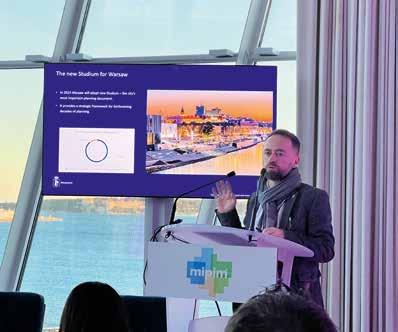
THE FUTURE OF THE CAR INDUSTRY SETTLING FOR POLAND
The real estate development sector is not the only industry that is experiencing growth in Poland. The automotive industry is also making significant strides. Mercedes Benz has opened a new factory in Jawor, Poland, which is set to produce electric vehicles (EVs) such as the EQC SUV. This is a significant development for the Polish automotive sector, as it represents a
major investment by a global automaker in EV production in the country. The factory is expected to create thousands of jobs and help to boost the local economy.
In addition, Volvo Cars has established a new research and development (R&D) center in Krakow, Poland, which is focused on software development and digital innovation. The center is expected to employ around 250 engineers and developers, and will work on
projects related to autonomous driving, electrification, and other cutting-edge technologies. This move is part of Volvo's broader strategy to expand its global R&D capabilities and stay at the forefront of the automotive industry's technological advances. Overall, these developments suggest that the Polish automotive industry is evolving and adapting to new trends and challenges, such as the shift towards electric and autonomous vehicles.
NEW LANDMARK PROJECT FOR WARSAW
One of the most significant Polish announcements at the event was the development of a 6.5-hectare mixed-use project called Towarowa 22, located in the Wola district of Warsaw. The project is a collaboration between Echo Investment S.A. and AFI Europe Poland and will comprise office towers, apartment buildings, rental housing, shops, cafes, and restaurants. Throughout the site there will be streets, footpaths, and cycle paths. The development will include a 150m office building. The remaining buildings will gently slope down to create a smooth transition from the metropolitan Daszyńskiego Roundabout area to Wola's historic buildings. The project aims to use green solutions and meet high environmental standards, making it a sustainable and functional development. Towarowa 22 will also incorporate historic factory building structures into a multi-level city park, creating a green enclave that the Wola district lacks.
WBJ.PL 25
DISCOVER UNIQUE LUXURY
RESIDENCES IN THE HEART OF THE CITY
Unique architecture, panoramic views, high quality, original motifs, and an unusual combination of a city center location and suburban privacy are just some of the many advantages of living in Towarowa Towers and Towarowa Square - investments without compromise developed by Asbud Group.
The entire complex of Asbud Group, carefully designed in the spirit of sustainable construction and complementing the architecture of the business center of Warsaw, will be composed of two 29-floor residential towers and three 7- to 12-story apartment buildings. The complex is a response to the demand for high-class premium projects in excellent locations, distinguished by sustainability and unique details.

26 APRIL - MAY 2023 WARSAW BUSINESS JOURNAL
LOKALE IMMOBILIA
PRESS MATERIAL
Towarowa Towers (marked with the letters A and B) and Towarowa Square (marked with the letters C, D, E) are other part of sustainable complex by Asbud Group, contributing to the development of Warsaw’s Wola.
TOWAROWA TOWERS – UNIQUE RESIDENTIAL TOWERS IN THE HEART OF THE CITY
Towarowa Towers is a first-class mix of modern architecture and high standards. The 95-meter towers will be made of high-quality materials - a minimalist combination of glass and aluminum. The character of the buildings is highlighted by colorful bay windows, creating a vivid cascade on the facade. At night, the towers will be recognizable by the decorative illumination that will shine on the exterior of the building, giving it a unique rhythm. Right from the doorstep, residents and their guests will be struck by the elegant lobby with its engaging and eye-catching graphic motif. A treat for aesthetes!
These projects offer a unique opportunity to those who want to combine what is paradoxically incompatible - the proximity of the bustling heart of the city and the amenities of a suburban home. This is possible, among other things, due to the vast terrace, which will occupy an impressive area of 900 m2, divided into two parts by a row of trees. Without leaving the building, residents can relax on its external portion, rest or chat in one of the lounge rooms, or train in one of the wellequipped fitness clubs.


TOWAROWA SQUARE - HIGH QUALITY AND OUTSTANDING AESTHETICS
Towarowa Square is a continuation of the quality and unique style of the first part of the complex –Towarowa Towers, but in a more intimate form. The project will consist of three 7- to 12-story apartment buildings made of high-quality materials – a combination of fiber-cement panels, glass, and wood. Towarowa Square buildings will house from 73 to 149 residential units, which will provide future residents with a large amount of privacy – something quite unusual in the city center!
The façade of the building will be varied with decorative elements around the windows, giving it a unique rhythm when arranged unevenly on the façade. In addition, colorful elements made of aluminum will create, on the one hand, a unique character of the building blocks, and on the other hand, a harmonious whole with the other part of the complex.
A UNIQUE LOCATION
This unique location is the hallmark of this complex. Towarowa Towers and Towarowa Square are the residential projects located next to the second metro line station – Rondo Daszyńskiego. The location in the heart of the capital city offers residents many opportunities. You decide what to do here and now. Just leave the house – you can easily reach the most important places on foot!
Towarowa Square and Towarowa Towers are other projects of Asbud Group that will develop the modern face of nearby Wola at Rondo Daszyńskiego in Warsaw while standing out with their original character and eye-catching details. The blocks of buildings, varied with additional, colorful window glyphs, will retain their individual style but will perfectly blend into with the modern development of this location.
The uniqueness of the Towarowa Towers project has already been recognized in international competitions. It became the Polish winner of the prestigious European Property Awards in two categories: Residential High Rise Development and Residential High Rise Architecture, and received an additional Five Stars award in the Residential High Rise Architecture category. The towers also boast the title of Gold Winner in the international Titan Property Awards 2022.
WBJ.PL 27
“The uniqueness of the Towarowa Towers project has already been recognized in international competitions”
PARTNER HIGHLIGHTS
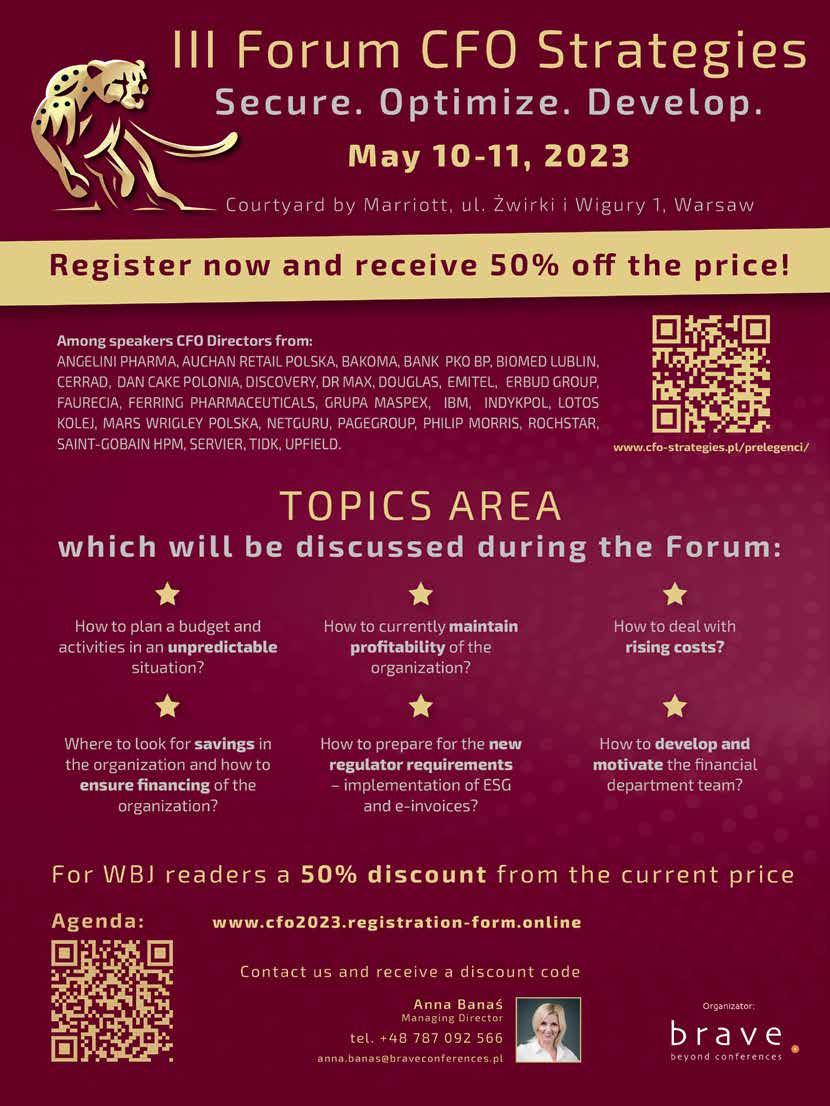
Hydrogen – oil of the future
Safe, abundant, and green – hydrogen is indispensable in the energy mix of any country looking to meet climate goals. Between strong backing from the government and a host of highly motivated industry stakeholders, Poland has seen a rapid rise in Hydrogen Valleys. The two recently created Hydrogen Academies are another signal that Poland is serious about hydrogen and is ready to stake its claim in this growing industry.
BY BEATA SOCHA
in Poland INVESTING
Nearly 150 years ago, the grandfather of science fiction, Jules Verne, said that water will become the coal of the future. The man who posited the possibility of traveling to the Moon and underwater ocean exploration, proved to be a visionary on fuel sources too.
With the EU curbing coal emissions in the hope of slowing down climate change and perhaps even reversing some of its effects, energy companies have been pulling all the stops to meet the ambitious goals.
Even the ruling Law and Justice, though historically lukewarm on renewable energy, has been tossing pretty impressive figures around. The Minister of Climate and Environment, Anna Moskwa, recently stated that about 73% of Poland’s electricity production will come from renewable energy and nuclear power by 2040, as per the updated Polish Energy Policy.
H2 IS IN
One of the main prongs in the new energy strategy is going to be made of hydrogen, the latest “hot” energy source. State-backed players are pulling any and all market stakeholders into the hydrogen game.
Energy Group, a photovoltaics producer, and Hynfra, a manufacturer of energy storage batteries, signed a contract for €22 billion to produce renewable hydrogen, ammonia, and methanol. “Watching global and European markets, we see how fast investments related to the production of green hydrogen and ammonia are growing. In our opinion, both are essential elements of green transformation and decarbonization,” the Managing Director of Energy Group Marian Glita said.
Fuel giant PKN Orlen has announced its plans to invest PLN 7.4 billion in hydrogen, including opening three hydrogen refueling stations: in Poznań and Katowice in 2023, and in Wałbrzych at the beginning of 2025.
WBJ.PL 29
Polish hydrogen valleys
Polish hydrogen valleys in which ARP S.A. is participants
Gdańsk
Warsaw
Kielce
Rzeszów Kraków
Wrocław Opole Katowice
Poznań
Szczecin
West Pomeranian Hydrogen Valley
Greater Poland Hydrogen Valley
Silesia and Lesser Poland Hydrogen Valley
Subcarpathian Hydrogen Valley
Central Hydrogen Cluster
Pomeranian Hydrogen Valley
Masovian Hydrogen Valley
MAP
Lower Silesia Hydrogen Valley
SHUTTERSTOCK
in Poland INVESTING
INFRASTRUCTURE IS KEY
Outside of electricity generation, the number of industries interested in this virtually unlimited energy source is expectedly long. However, the transport industry is clearly one of the main contenders to the podium. Municipalities across the country are more than eager to attract hydrogen investments, knowing full well that to be competitive, you need to be accessible.
The city of Rybnik recently touted its plans to open a second commercial hydrogen fueling station, near a public transport station. “This will be Poland’s second commercial, publicly available hydrogen fueling station. The hydrogen supplied to the station will come entirely from renewable sources, from so-called green hydrogen. The investor plans to put the station into operation in the second quarter of this year,” said Agnieszka Skupień, a spokeswoman
INVESTING INSIGHTS
Green energy on the rise
With or without sufficient regulation, the green energy market appears to be booming in Poland. Power from micro-installations (99% of which are photovoltaic ones) generated over twice as much power in 2022 and the year prior. A photovoltaic company ED Energia Polska increased its solar power contracts tenfold. Green transport solutions are also on the rise. Solaris recently sold 100 new low and zero-emissions buses
to Sardinia and signed new deals in Germany.
PKP Intercity is building a green train wash in Kraków.
Micro-installation power generation up 109%
In 2022 micro-installations introduced nearly 5.8 TWh of energy into distribution networks, which is 109% more than in 2021, according to a report published by the Polish Energy Regulatory Office (URE). As of the end of 2022, over 1.2 million micro-installa-
tions were connected to the power grid, with a total installed capacity of over 9.3 GW, 99% of which were photovoltaic installations.
The report also highlighted the dominance of prosumerowned micro-installations, which accounted for 96% of the total installed capacity.
EDP with record solar power contracts
EDP Energia Polska (EDP EP) has contracted over 50 MWp of
electricity in 2022, the best result since the company started its operations in Poland and more than 10 times higher than the previous year.The company’s growth was possible due to organic growth and acquisitions. EDP, a global leader in renewable energy, announced its strategy for 2026, which includes investing in projects related to energy transformation. The planned value of EDP projects worldwide is €25 billion. EDP Energia Polska provides photovoltaic solutions for businesses in Poland,
for the Rybnik municipality.
A network of fueling stations is absolutely essential to make inroads into passenger and cargo transport, which is a lesson learned from building the electric car segment. After years of slow adoption, the market for electric cars nearly doubled last year. The number of new registrations for battery-electric and hydrogenpowered cars soared 91.2% in February 2023 year-on-year, and reached 1,155 units, based
which include PV-as-aService, a solution that enables companies to avoid investing their own funds.
100 Solaris hybrid buses to head to Sardinia
Solaris will deliver 100 Urbino 12 hybrid buses to Cagliari, the capital of Sardinia.The contract is part of a framework agreement signed in 2021 with the joint-stock company Consip, which belongs to the Italian Ministry of Economy and Finance (MEF). Under
this agreement, public transport companies TPL (Italian:Trasporti Pubblici Locali) can order vehicles directly or tender with selected suppliers. Solaris vehicles will arrive in Sardinia in 2024. Over 1,500 Solaris vehicles already operate on Italian roads. Almost 30 percent of them are zero-emission electric buses and trolleybuses. Soon, 100 units of ordered hybrid vehicles will also appear on the Apennine Peninsula. Solaris is a European
30 APRIL - MAY 2023 WARSAW BUSINESS JOURNAL
SHUTTERSTOCK
What is “green” hydrogen?
on data from the Polish Automotive Industry Association.
The growth is all the more impressive when compared to the more conservative options: the number of plug-in hybrids (PHEV) registered rose by 20.7% to 991 units in the same period. While the growth is noteworthy, the green car segment is still relatively small and accounts for approx. 3% of new passenger car registrations.
HYDROGEN-FUELED SOLARIS
The growing attraction towards hydrogen options is also observed among bus and coach manufacturers, as demonstrated by Solaris, a Polish bus producer that has been owned by the Spanish group Construcciones y Auxiliar de Ferrocarriles since 2018.
The Solaris Urbino 12 hydrogen has been contracted for more than 200 units, 100 of which are already driving on the streets of Bolzano in Italy, Cologne, and Wuppertal in Germany, the South Holland region, and Konin in Poland.
The company’s latest model, an 18-meter hydrogen-powered bus, premiered back in the fall of 2022. Solaris has already received its first orders from the German carrier Stadt-
werke Aschaffenburg Verkehrs. The German company purchased two Urbino-18 and 10 Urbino-12 hydrogen buses to be delivered in 2024. Municipal transport operator Hamburger Hochbahn has ordered five Solaris Urbino 12 hydrogen buses. The zeroemission vehicles are expected to appear on Hamburg's streets as early as the second quarter of 2024.
HYDROGEN VALLEYS
Any new technology requires brainpower and with the industry turning towards hydrogen, Polish companies are looking to source expertise and talent, which so far is scarce. This is why the energy giants have decided to partner up with universities and other stakeholders to educate their own future staff.
In late 2022, Orlen partnered up with Toyota and the Polish train manufacturer PESA, as well as several universities: Łódź and Warsaw technology universities, as well as a research center of the Polish Academy of Science. Between March and June 2023, the first Hydrogen Academy will educate cherry-picked grad students, lured by paid internships and a potential offer of lucrative employment in a very promising industry. “Hydrogen is the fuel of the future and we need specialists who will help build this future,” said Daniel Obajtek, Orlen’s CEO.
leader in low- and zero-emission buses.
Eco train wash for PKP Intercity to be built in Kraków
PKP Intercity is investing in modern infrastructure solutions as part of its largest investment program in history. In Kraków, the construction of an ecological seasonal automatic train wash has begun at the local train station. The facility will be built within a year of the start of construction, and the
contractor for the contract worth PLN 21.9 million gross is Budimex.
“The wash will be environmentally friendly, improve the quality of services for passengers, and improve the working conditions of the Kraków train station crew, which is very important. Stateowned companies must be leaders of change in this regard, and I am very happy about that,” Maciej Małecki, Secretary of State in the Ministry of State Assets, said.
Another industry-university partnership quickly followed suit: chemical producer Grupa Azoty joined forces with the West Pomeranian University of Technology and created a Hydrogen Academy in Szczecin, part of the West Pomeranian Hydrogen Valley.
Just like automotive and aviation valleys in the past decades, hydrogen valleys started cropping up in Poland’s industrial centers in rapid succession. There are currently eight hydrogen industry clusters and they are primarily located in western and southern Poland.
While eight may not be a staggering number, it has already exceeded the plans laid out in “Poland’s 2030 Hydrogen Strategy” adopted by the Council of Ministers in November 2021, which aimed at creating five hydrogen valleys by 2030. The document also envisaged putting 800-1000 new hydrogen buses to use, with up to 32 hydrogen fueling and storage stations.
In contrast to gray hydrogen, which is generated from natural gas, green hydrogen comes from water. It is produced through electrolysis, a process of separating water into one atom of oxygen and two atoms of hydrogen. Currently, green hydrogen makes up less than 1% of global hydrogen production, but that is poised to change.
Another advantage of green hydrogen is that it can be transported using the existing gas pipelines, so in many cases the existing infrastructure may be sufficient for the new fuel. And it can also be used to produce green ammonia, the main component of common fertilizers. In view of current fertilizer shortages brought on by the war in Ukraine, finding an alternative source of fertilizers is of paramount importance.
How is hydrogen safe?
After the 1937 Hindenburg disaster, in which the airship caught fire and crashed, the use of hydrogen as fuel was deemed too hazardous or impractical to be secure. What makes the current storage technology safe enough to use hydrogen in passenger cars?
Firstly, hydrogen is stored in tanks constructed from materials that are highly durable and less likely to rupture or ignite. These tanks are engineered to contain any probable leaks. Secondly, significant advancements have been made in the development of sensors that can identify hydrogen leaks, pressure relief systems, and shutoff valves. The substantial investment in research and the increasing knowledge in the field make hydrogen fuel cells not only safe for storage but also quite convenient for transportation without compromising power.
WBJ.PL 31
IN 2024 POLAND WILL STRENGTHEN ITS POSITION AMONG

THE WORLD’S TOP-20 EXPORTERS
“Polish exports may exceed $400 billion in 2024, after an all–time high of $363 billion in 2022, making it one of the 20 largest exporters worldwide,” states Łukasz Grabowski, director of the Centre for Exports at the Polish Investment and Trade Agency.
32 APRIL - MAY 2023 WARSAW BUSINESS JOURNAL
in Poland INVESTING

WBJ.PL 33
INTERVIEW BY NIKODEM CHINOWSKI PORTRAIT BY TOMASZ TOŁŁOCZKO
in Poland INVESTING
WBJ: How are primarily export-oriented Polish entrepreneurs describing their current situation? How significantly did inflation and high production costs reduce the competitiveness of Polish goods?
Polish exporters, like their counterparts in other countries, have witnessed higher production costs and costs of raw materials over the past few months. However, despite this, they are continuously increasing their sales, which means that their competitiveness persists, although it should not be taken for granted.
Fortunately, more and more entities have started to understand that it’s not easy to offer quality when they are only competing on a price basis. Therefore, they are increasingly looking at quality and delivery speed, with some are even working hard to improve their organizational structures to further increase their performance, all in the interest of staying competitive.
So, what are the other competitive advantages of Polish producers except for lower costs?
Some of the main competitive advantages of Poland are location, area, and population size. Furthermore, it possesses a diversified manufacturing base, a sizeable skilled workforce and a ready domestic consumer market. Last but not least, it has a modern infrastructure that supports economic activity and attracts international investors. All of that explains why Poland has recently become a manufacturing and logistics hub in Europe. Today our country is considered as a gateway to Europe by more and more businesses.
Which sectors will be more and more present on global markets in upcoming years?
Over the past several years, technology has completely reshaped the market. The COVID–19 pandemic
It’s worth stressing that local companies have learned to adapt multiple pricing strategies to increase sales, especially during times of uncertainty and everchanging market conditions. This shift can be seen in the export statistics. Our analysis indicates that the current global situation is not an easy one. However, what’s positive is that Polish companies are actively looking for new clients abroad, improving production processes, and searching for new product niches.
For years, Polish exports were based on lower production costs than in Western Europe and the USA. That’s true. However, please remember that countries where production costs are high, e.g. Switzerland, Sweden or the USA are still maintaining their lead as the most competitive economies in the world. One of the main reasons for that are the unit labour costs, defined as the average cost of labour per unit of output produced. What we really need in Poland is to boost productivity growth.
made companies and industries move faster than ever before. New services were offered within a matter of days. Numerous businesses went digital overnight. In coming years, it is likely that we will see continuous developments in green energy, digital services, sustainable food, sustainable mobility, sustainable urban development, advanced manufacturing, biotechnology, quantum information science, digital health and more. The competition is fierce. Start-ups, SMEs and large corporations are all seeking to innovate, go to market, and grow their businesses quickly, all while competing for scarce resources.
And which sectors that currently dominate Polish exports will be overtaken by companies from other countries?
It's hard to point out those sectors. One can assume though that labor-intensive industries might face greater challenges than others as unit labour costs are often viewed as a measure of price competitiveness.
34 APRIL - MAY 2023 WARSAW BUSINESS JOURNAL
Polish entities, if they are willing to be part of global value chains, need to pay greater attention to environmental, social, and corporate governance (ESG) programs as customers will increasingly start requesting these type of certifications.
What actions have the government and current administration taken to support Polish exporters in the face of such high inflation?
The Polish government has implemented certain tax cuts under the Anti-Inflation Shields. For several months, Poles have been paying less for fuel, basic foodstuffs, natural gas, system heating, as well as fertilizers. Further, the reduced VAT rate on electricity has been in effect for several months. It was one of the most extensive anti-inflation programs in Europe. In total, the government measures saved Poles nearly PLN 25 billion.
Okay, but most of that money went to final consumers and did not support exporters. What about PAIH’s activities? You are one of the leading government agencies whose goal is to support Polish companies in their foreign expansion. What projects and programs is PAIH currently directing towards Polish entrepreneurs?
We naturally see ourselves as the first point of contact for all Polish companies wanting to expand globally, whether through exports or investments. Currently, alongside our statutory tasks, PAIH is running the project “Polish Tech Bridges” which provides SMEs with professional tools that prepare them to expand outside the EU. The maximum grant for one SME is PLN 200,000.
Soon, we will have more information about the “Go To Brand” program. Micro, small and medium-sized enterprises registered in Poland and operating in highly competitive and innovative sectors such as IT/ICT, medical equipment, automotive and aviation components, biotechnology and pharmaceuticals can receive funding to participate in fairs, exhibitions, business missions or conferences abroad, as well as benefit from consulting services to help them promote themselves in foreign markets.
Additionally, I recommend checking PAIH’s website for the latest news and insights about PAIH’s upcoming events and information about foreign markets. It’s also worthwhile to bookmark trade.gov.pl. This portal provides useful information about exports and foreign trade.
According to PAIH, what are the biggest threats to exporters in the coming months and quarters?
We don’t quantify it as a threat but as a challenge. Polish entities, if they are willing to be part of global value chains, need to put greater attention to issues related to ethical and environmental, social, and corporate governance (ESG). National security rules and
human rights certifications will continue expanding into ESG programs. More customers may start requesting these types of certifications. At PAIH, we strongly recommend that Polish entities start carefully mapping their supply chains.
Other than that, we should not forget about environmental, societal, economic, and geopolitical threats that materialize every now and then such as climate action failure, extreme weather, biodiversity loss, human environmental damages and natural resource crises.
What about strictly economy-driven threats or challenges?
Economically, it’s worth observing how global economies develop, especially emerging ones. As of now, nine countries are in debt distress, twentyseven countries are at high risk, twenty-six countries are at moderate risk, and seven countries are at low risk of debt distress. Recently, Sri Lanka has defaulted on a massive debt. We may hear more such stories in the future.
Considering the above, what do you forecast for Polish exports in 2023 and 2024?
The value of Polish exports reached an all-time high of $363.3 billion in 2022, an increase of more than 6% compared to 2021. The more positive the growth prospects for the world economy are, the better the exports results of Poland may be in 2023 and in 2024. Any result close to $400 billion worth of products exported by the end of 2023 should be considered a success for Polish businesses. I assume the value of products exported from Poland may exceed $400 billion in 2024. Consequently, Poland will be strengthening its position as one of the 20-largest exporters worldwide.
ABOUT PAIH
The Polish Investment and Trade Agency (PAIH) –supports both the foreign expansion of Polish business and the inflow of FDI into Poland. PAIH also aims to boost Polish exports. PAIH supports Polish business in overcoming administrative and legal procedures related to specific projects and assists in developing legal solutions, finding suitable locations, reliable partners, and suppliers. The agency also implements pro-export projects such as "the Polish Tech Bridges" dedicated to the expansion of innovative small and medium-sized enterprises.
WBJ.PL 35
Kraków – Planning for an even more successful future
The Warsaw Business Journal interviews Deputy Mayor of Kraków Jerzy Muzyk about the city’s achievements in recent years, and how they are looking to build on their success.
WBJ: What is the status of the three strategic urban development projects in Kraków ?
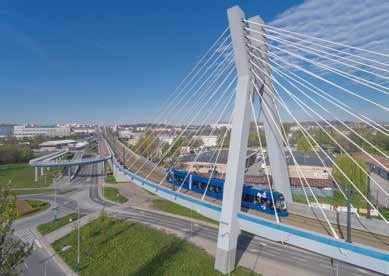

Jerzy Muzyk:"Kraków Nowa Huta of the Future" (Kraków Nowa Huta Przyszłości) is a strategic project that will affect the functioning of the entire region. It assumes the implementation of four separate investment projects: the "Branice" Science and Technology Park, the "Ruszcza" Logistic-Industrial Center, the "Błonia 2.0" Large-Scale Outdoor Cultural Events Center, and the "Przylasek Rusiecki" Recreation and Leisure Center. The project's assumptions are based on the synergy of these areas, which will be connected not only spatially but also ideologically by the Nowa Huta Przyszłości Trail.
The "Wesoła" project concerns the creation of a multifunctional urban area, providing new spaces for residents and public life. The project's goal is to preserve the area's unique values, protecting the cultural and landscape environment, creating an attractive public space, and increasing the diversity and quality of the service program. One of the first buildings constructed in this area will be the headquarters of the Kraków Library, which will include both workshops and reading rooms.
The "Kraków Fast Tram" (Szybki Tramwaj) is part of the fourth stage of expansion and assumes the construction of a line connecting the loop in Mistrzejowice with the intersection of Meissner and Lema streets (the 4.5-kilometer route will be completed by the end of 2025 and will shorten travel time to the center by about 12 minutes). The entire investment is worth PLN 1.92 billion and will be implemented under a public-private partnership model.
Kraków is highly developed in terms of business service centers and R&D. How many people are employed in this sector, and how many of them are foreigners?
For several years, Kraków has been a European leader in attracting modern business service centers and, more recently, R&D centers. During the global crisis in 2007-2009, while others were losing, the capital of Malopolska was gaining more investors, showing increases not only in the number of companies but also in the number of employees. The same can be said about the difficult pandemic period, which did not weaken the potential of Kraków's companies but actually accelerated the development of innovation-based businesses operating in a highly competitive environment.
36 APRIL - MAY 2023 WARSAW BUSINESS JOURNAL
ICE Congress Center, Vistula River and Grunwald Bridge
TOP PRESS MATERIAL, BOTTOM SHUTTERSTOCK
Kraków Fast Tram
According to data collected annually by the industry association ABSL, there are more than 260 business service centers in Kraków employing over 92,700 people (including 43,100 in SSC/GBS, 17,900 in IT, and 19,000 in BPO). These numbers show that Kraków has been an employment leader for years (showing a 23.2% share of employment in the sector overall). Every fifth employee in these business service centers is a foreigner. That adds up to already more than 20,000 people from 50 countries. According to forecasts for 2023, further employment growth in this sector is anticipated.
Kraków is well-known for being a university city. What is the local government doing to promote education and attract students to Kraków ?
In 2021, following the conclusion of an agreement for a common goal between the Kraków Science and Academic Center and the Municipality of Kraków, a Council of Partners was established with the intent of making Kraków the most recognizable scientific and academic center in Central and Eastern Europe, attracting the best students and scientists from around the world.
The partners declared the intention to undertake actions aimed at creating new job opportunities, including for those with the highest professional competencies, through the development of student internships and professional internships in cooperation with academic career offices. In addition, the goal of the partners is to create scholarship programs for high school students, university students, and young scientists with outstanding academic achievements. These actions will be implemented in cooperation between the City of Kraków, higher education institutions, and businesses.
We are working on creating an electronic platform called iKONA, where information about competitions and scholarship programs for students and graduates of Kraków 's universities will be posted, among other things. The iKONA platform will also be a place to publish job and internship offers.
Many important business events take place in Kraków. Which ones are particularly important for the city?
It is important for Kraków to develop local business and promote the city as a modern center for research and development. Therefore, it is no coincidence that the next ABSL Summit will be held in our city. It is one of the most important socio-economic events in Central and Eastern
Europe, bringing together over 1,000 business leaders representing the largest companies in the world, representatives of public administration and academia, experts, and scientists.
This year also brings one of the most important congress events in Poland – the Copernicus World Congress. It is also the most important event of the Kraków part of the 550th anniversary of the birth of Nicolaus Copernicus. The congress will focus the attention of Poland and the world directly on Kraków, where our greatest astronomer lived, worked, but above all, studied. The congress, held on 23-26 May
It is important for Kraków to develop local business and promote the city as a modern center for research and development.
2023, will host the world's leading scientists. In 2023, the International Biennale of Architecture (MBA Kraków 2023) will also be held at the ICE Kraków Congress Center, organized by the Association of Polish Architects, Kraków Branch. As every year, we will also continue successful cyclical events, such as the Open Eyes Economy Summit, which deals with responsible business, and Digital Dragons - the largest gaming industry conference in this part of Europe.
I recently visited Kraków and noticed many Ukrainians on the city streets. How many Ukrainians currently live and work in Kraków,
and how have they and the city adapted to this new situation?
Currently, there are just over 30,000 refugees from Ukraine living in Kraków, and almost 10,000 refugees living in the immediate vicinity of the city (Kraków County) (data from the Border Guard as of January 2023). The growth rate of the foreign population is high, as seen, for example, in educational institutions: year-on-year, the number of foreigners has increased more than fourfold (from 4,120 in 2021 to over 17,000 in 2022) - 85% are Ukrainians.
Before the Russian invasion of Ukraine, estimates indicated that
Kraków employs over92,700 people (including 43,100 in SSC/GBS,17,900 in IT, and 19,000 in the BPO).
there were around 70,000 Ukrainians in Kraków, which would have meant that as of January 2022, Ukrainian immigrants accounted for almost 10% of the city's population. If the refugees who have stayed in Kraków will stay "longer," one can expect an increase in the share of foreigners in the city's population, even up to 20%.
The presence of refugees in Kraków is not only a major challenge for the housing, education, healthcare, and other systems, but also necessitates the accelerated development of a comprehensive policy for the integration of foreigners in the city, and thus for Kraków itself.
WBJ.PL 37 SPONSORED
International connections through acquisitions and investments
Although 2022 was a difficult year fraught with many challenges, Raben Group ended it with impressive results: revenues of more than €2 billion, the number of international lines increased by 10%, and monthly freight volumes reached almost a quarter of a million shipments.

38 APRIL - MAY 2023 WARSAW BUSINESS JOURNAL COMPANY SPOTLIGHT
The development of connections is part of the big European jigsaw puzzle that Raben Group has been completing and expanding systematically for several years. It is made possible by acquisitions of companies in existing markets and completely new investments in facilities and the fleet. This allows for the construction of strong national networks, which can then be linked together into an agile pan-European network. This, in turn, is a prerequisite for meeting growing trade and market needs while remaining competitive and staying in the lead among European carriers.
In 2022, the Raben “family” expanded to include the operator Bexity, a longstanding partner operating in Austria, with 16 depots and a strong rail freight support. A year earlier, the Group entered the southernmost market by acquiring the Greek logistics provider Intertrans. Meanwhile, acquiring German Luible Logistik GmbH and Dutch BAS Group helped strengthen Raben's presence in these countries.
The past year was also filled with investments. In Poland, a new depot was opened in Warsaw's Annopol and the expansion of the logistics center owned by Fresh Logistics Polska was completed. There were also changes in Germany: a new branch in Herborn, Hesse started operations, while in Lower Saxony Raben moved from Langenhagen to Sarstedt, where it now has ten times the logistics capacity. The Group already managed to launch a depot in the new market in Inzersdorf in the southern part of Vienna. A warehouse in Győr, Hungary, was commissioned in 2022, and final technical acceptance of an enlarged to nearly 7,500 m2 cross-dock facility in Dunaharaszti on the outskirts of Budapest is also underway. Finally, in the Netherlands, the EttenLeur depot and the new Hazerswoude depot are now operational, and the first zero-emission warehouse in fifteen markets is being built in Oss.
2023 promises to be even more spectacular in terms of infrastructure development. A brand new facility has been operating since February in Aichach, Germany, and the opening of another distribution center in this market is planned, in addition to a major new investment in Rokycany near Pilsen (Czechia). All these projects are forming the foundation for Raben Group's scaleup and the merger of selected locations already seems a formality.
This is the next phase of the strategic Trade Lane project which was initiated in 2018. Initially concerning two countries (Poland - Germany), it grew significantly after three years (in 2021, Bulgaria, Romania, Hungary, Czechia, Slovakia, Poland, Lithuania, Latvia and Estonia joined) and now it automatically covers every market Raben Group enters. The operator integrates the distribution networks of the acquired companies into its own connection system, and in addition, it launches new lines. This strategy is yielding tangible results: by the end of 2022, Raben already had more than 600 international connections in Europe, about 10% more than the year before, while the monthly number of shipments more than tripled - from 70,000 to more than 234,000. Almost a third of this offer, or 180 lines, are the so-called groupage linehauls running between the mentioned CEE countries. In the last 12 months alone, the Group has launched more than 40 new routes in this vitally important region. This result was made possible by also opening the smallest depots in each country to direct international volume exchange.
“The CEE region has become the strongest area and has overtaken the hitherto prioritized traffic between Poland and Germany with a 10% increase in transported volume despite the first signs of crisis. This was made possible by almost 130 daily groupage connections, which are constantly monitored and adapted to changing volume flows”, according to International Road Network Director
Łukasz Lubański. “Additionally, Raben Group's infrastructure investments in Rokycany, Czechia, and Aichy, Bavaria, are expected to have a significant impact on the company's development and its ability to handle export and import from Germany to countries like Italy, Austria, Greece, Czechia, Slovakia, Hungary, Romania, and Bulgaria. Raben Group is responding to the market's and customers' expectations in the changing economic situation and global logistics chains by reacting quickly and decisively to meet their diverse needs,” he adds.
The company has yet to say its last word in this area. The volume of shipments handled can grow further, as thanks to investments in infrastructure and new lines, Raben will be able to reach more places in Europe directly, not only the large ones but also smaller economic centers.
WBJ.PL 39
“
PRESS MATERIAL
Raben Group is responding to the expectations of the market and customers in the changing economic situation and global logistics chains by reacting quickly and decisively”
EUROPE’S MILITARY POWERHOUSE
Putin’s gamble in Ukraine has cost his country dearly, both in war casualties and economically. With the strengthening geopolitical winds, Poland is arming its troops to an unprecedented degree, sourcing gear from all over the world. The country, geographically positioned to safeguard NATO’s and EU’s eastern flank, is quickly becoming one of the best equipped armies in the world.
 BY SEAN REYNAUD
BY SEAN REYNAUD
40 APRIL - MAY 2023 WARSAW BUSINESS JOURNAL
NUMBER OF POLISH TROOPS

(each figure represents 10,000 soldiers)
CURRENTLY GOVERNMENT PLANS FOR 2035
The K9 Thunder weighs 47 tons and is armed with a 155mm gun produced by Hyundai with a barrel length of 52 calibers, which has a range of 30 to over 50 km depending on the ammunition used. The vehicle is powered by a 735 kW (1000 HP) engine produced under German license.
The ongoing war in Ukraine has made Russia’s President Vladimir Putin a significant player in arms sales in Europe, but he has also become persona non grata in most of the democratic world. To counter Russia’s appetite for western expansion, NATO has expedited its efforts to accumulate equipment. European countries are concerned about their own munitions stockpiles, and in conjunction with Ukraine’s increasing requests for more, the situation is worsening. As a result, weapons companies are seeing a surge in their shares on the stock market as governments within Russia’s reach are forced to rethink their defense budgets.
THE FIRST TIER
To safeguard Europe from Russian aggression, Warsaw and its NATO allies have increased their military arms procurement. At the NATO headquarters in Brussels, leaders have suggested implementing multiple levels of readiness, with a first tier consisting of approximately 100,000 soldiers ready to mobilize at ten days’ notice. Poland, Norway, Estonia, Latvia, and Lithuania are among the countries that could contribute soldiers to the first tier.
Poland’s location has always put it in the crosshairs between the East and the West and the country has historically suffered at the hands of neighboring superpowers. While having powerful allies is crucial, it is no surprise that the country’s leaders have determined that possessing a formidable army is equally vital.
In the wake of Russian aggression against Ukraine, the Polish government announced it plans to increase its troops nearly two-fold over the next decade from 170,000 currently to 300,000 by 2035.
Prime Minister Mateusz Morawiecki stated in January, “The war in Ukraine forces us to arm even faster, which is why this year we will allocate 4% of GDP to military needs.” He added that it would probably be the highest percentage among all NATO countries.
A SPENDING SPREE
Poland has invested heavily in new tanks to modernize its military arsenal. In the spring of 2022, Warsaw ordered 250 American Abrams tanks to replace outdated Soviet-era tanks, which it had rushed over the border to aid Ukraine in the early days of the war.
The K2 Black Panther tank is armed with a smoothbore 120mm gun and weighs 55 tons. The crew consists of three people (commander, gunner, and driver), and the vehicle’s suspension allows for ground clearance adjustments. Power from the Korean diesel engine is transmitted by a German transmission. In the K2PL version, the tank also has reinforced armor, an all-round observation system, and an active protection system.
But the real shopping spree came in late 2022, when Poland signed armament contracts with South Korean company Hyundai Rotem to deliver tanks. As a result, the K2 tanks and K9 self-propelled howitzers have become part of the first delivery of South Korean weapons purchased by Poland. The entire contract is worth $3.37 billion.
The country will spend an additional $2.4 billion on tracked self-propelled howitzers from another Korean weapons manufacturer, Hanwha Defense. Altogether, Poland will receive 189 tanks and 212 howitzers.
MORE IS BETTER
The Korean equipment offers Poland excellent value for its money as it quickly expands its defense capabilities. "The war of attrition in Ukraine has shown how important it is to have a large quantity of low-cost equipment," Frederic Mauro of the Institute of International Relations (IRIS) told Le Figaro.
Having the most technologically advanced weapons is good, but having access to a lot of equipment quickly is better when facing an enemy with vast manpower reserves. According to the paper, once all the ordered tanks are delivered, Warsaw will have four times the number of tanks as the French army.
FEATURE PREVIOUS SPREAD AND THIS PAGE SHUTTERSTOCK
42 APRIL - MAY 2023 WARSAW BUSINESS JOURNAL
AIR, LAND, AND SEA
Poland still has gaps in both air and sea capabilities compared to the French and British armies. However, the country is also modernizing these branches of its armed forces by signing contracts for the delivery of F-35 fighter jets and FA-50 aircraft. It has also signed a contract for three British frigates and two spy ships with the Swedish company Saab.
These moves underscore Poland’s efforts to strengthen its military capabilities in all areas, including air and sea power, and position itself as a significant regional player.
HEREDITARY ENEMY
Poland’s incremental rise in military significance could not have gone unnoticed. Until recently, the object of derisive accusations by EU bureaucrats, twhe country is now a leading power in Europe. Ivor Roberts, former British ambassador to Yugoslavia, Ireland, and Italy, wrote recently in The Daily Telegraph that it wasn’t long ago when Poland was considered a problem child in the EU. At one point, its constitutional court ruled that fundamental parts of EU law were no more important than its national constitution. “How different it is now that Poland has assumed the role of a bastion of Western defense – a key nation on the front line of the fight against Putin’s Russia,” Roberts stressed. “Warsaw is invariably at the forefront in supporting Kyiv: diplomatically, militarily, and morally, as it deals with the largest number of Ukrainian refugees.”
Former director of the European Defense Agency, Claude-France Arnould, explains that the threat from Russia has always existed for Poles and will remain a long-term concern. “Already at the NATO summit in Bucharest in 2008, the Poles were on alert. Historically, Russia is their hereditary enemy,” Arnould added.
DEMOCRATIC ENCIRCLEMENT
The incursion into Ukraine clearly demonstrated Russia’s territorial aspirations, evident throughout its history, including the annexation of Crimea in 2014, its longstanding meddling in Georgia (Abkhazia and South Ossetia) in 2008, and Chechnya in 1999. These actions highlight the extent to which Russian President Vladimir Putin is prepared to go in his efforts to revive a Russian empire and counteract what he sees as a “democratic encirclement,” as pointed out by Professor Hein Goemans from the University of Rochester.
Putin’s political future relies on preserving secure borders and establishing a circle of obedient allies reminiscent of the Soviet Union and its satellite states. To achieve this, Russia must prevent encirclement by antagonistic democratic governments, a threat that it chose to “counteract” by launching military operations that cost approximately $900 million per day in Ukraine alone.
Over a year into the conflict, the consequences of Putin’s aspirations may well have wider social and political implications for all parties involved - Russia, Ukraine, and Europe. Russia’s clear miscalculation as to the determination of the West could potentially result in its downfall.
“UNCLE VANYA”
Russia has suffered from sanctions and condemnation worldwide due to the detrimental effects of the invasion. The departure of more than 300 foreign companies from the nation has prompted some amusing resourcefulness among Russians, who have renamed abandoned McDonald’s branches "Uncle Vanya.”
The West hoped that the void of departing corporate investment might compel Russia to engage in peace negotiations with Ukraine. Instead, the Russians weather the storm of international condemnation via backdoor deals and discounted petroleum to nations like India, as well as backup routes to sell sanctioned Russian crude oil through Iran.
In February of this year, oil and gas condensate production in Russia returned to pre-sanction levels of 1.508 million tons per day, aided in part by President Putin’s decree that prohibited domestic oil exporters and customs bodies from adhering to Western-imposed price caps on Russian crude.
NOT ENOUGH?
Trade experts have acknowledged the effectiveness of multinational cooperation in imposing sanctions, but it remains uncertain whether Russia will succumb to economic pressure, particularly in light of the opposition from its allies that undermines international efforts.
As a result of the military operations conducted by Putin’s troops, which have involved multiple violations of the laws of war, the International Criminal Court has issued a warrant for the arrest of the Russian president. The bombing of civilian areas, executions, and violence are the hallmarks of Putin’s military actions. Consequently, the civilian death toll in Ukraine has exceeded 8,000, while the number of injured is more than 13,000.
“ Poland has assumed the role of a bastion of Western defense – a key nation on the front line of the fight against Putin’s Russia
WBJ.PL 43

44 APRIL - MAY 2023 WARSAW BUSINESS JOURNAL
WORLDS APART,
YET SO ALIKE
The recent arms deals between Poland and South Korea have brought these two countries on opposite sides of the globe together in more ways than one.
 BY SEAN REYNAUD
BY SEAN REYNAUD
THE EFFECTS OF THE WAR
in Ukraine are reshaping not only Europe but also extending as far east as South Korea. The war has led to a remarkable 140% increase in South Korea’s arms exports in 2022, reaching a record $17.3 billion, with agreements worth $12.4 billion signed with Poland.
Seoul’s long-standing endeavor to establish a domestic arms industry has finally come to fruition, catapulting it from the 31st spot in global arms sales in 2000 to the eighth position in the 2017-2021 period, accounting for nearly 3% of the world’s total defense exports, as per the Stockholm International Peace Research Institute (SIPRI).
The orders from Poland are helping South Korean President Yoon Suk Yeol fulfill his promise to make his country the fourth-largest weapons exporter by 2027, following the United States, Russia, and France. The surge in arms exports will also assist South Korea in offsetting the increase in its domestic defense budget required in response to China’s 7% boost in defense spending for 2022. “It’s a gold rush period for arms producers,” SIPRI’s Siemon Wezeman told Forbes.
BREAK WITH MOSCOW
The South Koreans were impacted by the Russian-Ukrainian war in other ways, too, as they had to adjust their relationship with Russia, which was now under some of the strictest international sanctions in history.
South Korea’s ties to Russia provided Seoul with the help needed for its nascent space industry in the mid-2000s. Russia played a significant role in the development of the KSLV-1 rocket, which was part of a program that ran from 2009 to 2013. South Korea relied heavily on Russian expertise in rocket propulsion and had a contract to launch South Korean satellites into space using Russian rocket technology before the sanctions were imposed. The sanctions severely impacted South Korea’s plan to launch a national security monitoring system, which is again detrimental to their national security.
SHIFTING ALIGNMENT AND NEW ALLIES

While Russia and South Korea have been on friendly terms in the past, this by no means implies that they are necessarily allies.
Vladimir Putin warned South Korea against aiding Ukraine militarily and has implied that direct aid to Ukraine would force Russia to deepen military ties with North Korea, including the sale of fighter aircraft. South Korea, for its part, has taken care to ensure that while exporting weapons to other nations, it does not intentionally aid Ukraine against Russia. If, however, those arms end up in Ukraine through one of South Korea’s allies, this does not imply direct military support for Ukraine. One expert at the Asan Institute for Policy Studies in Seoul, Yang Uk, stated that he doubts South Korea would enforce its export controls.
46 APRIL - MAY 2023 WARSAW BUSINESS JOURNAL
FEATURE
PREVIOUS SPREAD AND THIS PAGE SHUTTERSTOCK
Orders from Poland are helping South Korean President Yoon Suk Yeol fulfill his promise to make his country the fourthlargest weapons exporter by 2027, after the United States, Russia and France.
It is, therefore, hardly surprising why a partnership with Poland is so lucrative for South Korea, both economically and geopolitically.
In February, South Korea’s Defense Minister Lee Jonsup and his Polish counterpart, Mariusz Błaszczak, met to deepen the security cooperation on the back of last year’s deal to supply tanks, howitzers, and fighter jets to Poland. They agreed to “systematically” manage defense and arms industry cooperation and also agreed to hold joint military drills to share their perspectives on Korean-made weapons.
A HISTORIC DEAL
The $8.8 billion arms deal includes 100 Chunmoo rocket launchers, 180 K2 Black Panther tanks, 24 K9 self-propelled howitzers, and 48 FA-50 aircraft. The Chunmoo multiple launch rocket came into play as Lockheed Martin was unable to meet Poland’s request to increase its order of High Mobility Artillery Rocket Systems (HIMARS), used by Ukraine against Russia with devastating effect. It is the first time a NATO member other than Turkey has turned to suppliers outside the alliance for major weapons systems.
Korean arms dealers Hyundai Rotem, Hanwha Defense, and Korea Aerospace Industries have gained a competitive advantage by prioritizing “mid-level weapons” over aircraft carriers, nuclear submarines, or cutting-edge aircraft. In addition, they offer to transfer technology and facilitate local production, thereby boosting the domestic defense industries of their customers. South Korean howitzers, for example, will be produced in Poland by local partner industries.
NUCLEAR PARTNERSHIP
Poland is not only sourcing tanks from South Korea. Polska Grupa Energetyczna (PGE) and ZE PAK together with Korea Hydro & Nuclear Power last year signed a letter of intent for cooperation in the construction of a nuclear power plant in Pątnów.

Poland’s Prime Minister Mateusz Morawiecki said that after the recent arms deals, “our cooperation with South Korea is progressing into new areas.” He also emphasized the importance of nuclear power for the country’s energy security, which faced one of the biggest stress tests last winter, as natural gas shipments from Russia all but halted.
The partnership with South Korea is expected to come to fruition in the middle of this year.
FRANKEN-KRAB
The Krab Howitzer is a noteworthy weapon system produced by Poland through a combination of different parts from several countries. The Krab self-propelled howitzer initially won an international competition to meet the artillery system requirements of the Polish Army. The design includes a South Korean K9 Thunder chassis, a British BAE System turret, a French Nexter Systems 155mm gun, and a Polish fire control system.
As of November 2022, Poland had delivered 54 Krabs to Ukraine, some of which were built without the K9 chassis. While this may suggest South Korea’s involvement as a weapons supplier to Ukraine, the Koreans have explicitly informed their American allies, with whom they negotiated the sale of artillery shells, that they will not provide arms to Ukraine and are unlikely to do so in the future. South Korea does not intend to interfere in the conflict, but rather to benefit from the global arms trade, as weapons dealers have always done.
SO DISTANT, SO SIMILAR

One might question how an Eastern European country like Poland ended up buying weapons systems from a country on the other side of the world. A cynic might suggest that Warsaw simply sought the means to defend itself and that South Korea, with its burgeoning arms industry, provided what Poland needed. However, upon further examination, it becomes clear that Poland and South Korea have faced similar challenges with their neighbors, making it natural for them to collaborate.
Both countries have battled against stronger foes to protect their cultural and linguistic heritage, having been conquered and even erased from the map. Yet, they persevered and emerged from the ashes of their enemies as equals to stand their ground. If Poland and South Korea work together it is not only that they see opportunity in each other, but that they have learned from history and have genuine empathy for one another as victims of foreign aggression.
WBJ.PL 47
South Korea’s arms exports in 2022
$17.3 bn total $12.4 bn to Poland alone
The Added Value of Interim Management in a Family Business
An interim manager is an experienced professional focused on achieving specific business goals. When a family-owned business organization lacks the resources or appropriate skills required to tackle a critical challenge, interim managers can provide a proven, fast, and cost-effective solution.
BY DR. KATARZYNA SOBAŃSKA-HELMAN
Interim managers are brought in for a specific period to work alongside the in-house managers, providing the support they need and the expected business results. The essence of this business relationship is a company analysis, diagnosis, creating a vision of change, recommendations, and implementation in conjunction with the company's owner or management team.
Family-owned companies play a significant role in the global economy due to their stable nature, long-term vision, and commitment to their employees. They are a driving force behind economic development. However, they differ from
other organizations regarding culture, entrepreneurship, sustainable development, and decision-making approach. Their functioning is determined by the constant tension and interplay between the family and business elements, which directly affects what happens in the company and how it happens. This tension shapes their investment plans, organization, decisionmaking processes, and communication.
Interim managers can add substantial value to family-owned companies and quickly fill company competency gaps by taking over temporary management. Moreover, thanks to the knowledge transfer typical of the interim formula,

filling the gap is permanent, even after the project has been completed.
Ironically, what once determined the strength and success of many familyowned companies, particularly the charismatic, strong, and typically patriarchal management style, can impede their growth later. A strong culture helps gain market share and achieve dominance over the environment, but it also creates specific weaknesses, contradictions, and threats that are rarely found elsewhere.
As illustrated by the following examples, an interim manager is indispensable in addressing some of the most significant challenges and hurdles.
48 APRIL - MAY 2023 WARSAW BUSINESS JOURNAL SHUTTTERSTOCK FEATURE
CASE #1: Success in succession. Entrepreneurs running family businesses want to maintain the company and pass it on to the next generation. This is not always easy and possible. For several reasons, up to 64% of family businesses do not have a succession plan, even though it is critical to the company's development, employee engagement, talent retention, and successor authority building. External help is needed to reduce the risk of losing the knowledge, skills, and vision built up over the years. Successioninterim managers can help to formulate answers to key questions: Which family member is the right candidate? What to do when the potential successor is not yet experienced enough or when internal family succession still requires time?
The interim manager's distance and lack of family relationships are an asset, especially in situations with several potential successors. Interim managers can also support current leaders and successors by taking over the company's management during the succession, thus ensuring the liquidity of this generational change in the company's leadership. They reorganize corporate and business relationships with specialized lawyers, maintaining the founder's and successor's visions.
CASE #2: Obtaining a catalyst for change in a company with a strong organizational culture.
I have dealt with organizations with integral, strong, and distinctive cultures. Nobody working there had any problems clearly defining the company’s rules and values. This unique organizational culture had contributed to achieving spectacular results in the past, so it was natural that attempts to challenge those rules were treated as an attack on the identity that had become a value in itself. Any proposal of change encountered strong resistance. The stronger the company's identity and culture, the greater the resistance and aversion to change. However, this refusal to change impeded cooperation and the ability to react quickly to various environmental changes, making it difficult to absorb innovations, which usually arise from the interaction.
Interim managers are increasingly invited to family businesses to initiate development projects, co-create market strategy, enter new markets, including foreign ones, or otherwise break through cultural resistance that impedes business development. They transform thinking, goals, and the direction of further development, translating them into specific business solutions and implementing them.
CASE #3: Multitasking and multiassortment
Many Polish family-owned companies were established in exceedingly difficult conditions in the 1990s. They endured several crises, hyperinflation, and dramatically changing supply chains. Therefore, the basis of many past business decisions was a conscious effort to achieve the company's and family's independence from the business environment, capturing as much of the supply chain as possible and running businesses that are entirely unrelated to the core business. Such an approach partially freed the company from external suppliers and even enabled them to survive. However, today these activities simply draw attention away from the core business.
Interim managers can prepare organized parts of companies for sale and reorganize businesses. They simplify and make it more efficient. They develop key strategic partnerships that replace organic solutions built and maintained within the company.
CASE #4: Family Relations and Difficult Emotions
Planning for succession can be challenging due to the strong connections and emotions associated with family ties. The owner is under tremendous pressure when faced with decisions about transferring power in the company they founded. They need a healthy distance to conduct and regulate succession agreements and plan for retirement. Family relations and the obvious intention not to harm anyone are additional obstacles. The owner wants to avoid hurting the feelings of certain family members and feels pressure from children who are often in their 40s and
waiting for their turn. As a result, companies delay their succession planning.
Barriers to development resulting from the domination of the family system over the company and ownership system are significantly reduced or eliminated by an independent manager who evaluates succession scenarios realistically and with distance. An interim manager can immerse themself in the family business and build a bridge between the past and the future, reconciling the goals of different individuals who often confuse family conflicts with their roles in the company.
Interim experts have the potential to generate substantial benefits by facilitating turnarounds, change management, or implementing improvement initiatives. The popularization of the interim management formula provides companies with quick access to highly experienced practitioners, leaders, or specialists. The possibility of temporary outsourcing of business management is a solution that meets the needs and specificity of family businesses.
To optimize the use of interim professionals, it is crucial to clearly understand when, how, and why to utilize them. Once you've decided to engage interim experts, the key is to carefully select the appropriate candidate and provide the necessary support to achieve the highest possible outcome.
WBJ.PL 49
“Crises and economic ups and downs are pretty much the natural order of things – that's why economists call them economic cycles”
Get a Polish business news briefing in English delivered to your inbox each weekday before 9:00
Scan code & Sign up now for a no-obligation 2-week trial.

METAVERSE –BLUE OCEAN OF OPPORTUNITY OR A WHITE WHALE?
The concept of an immersive virtual environment with its own economy, real estate, fashion and consumer goods has been the dream of many tech enthusiasts. Now that the technology is here and its application seems plentiful, some of its biggest backers are pulling the plug. Is the metaverse going to end up on the cutting room floor or repurposed for different applications?
 BY SEAN REYNAUD
BY SEAN REYNAUD
WBJ.PL 51 SHUTTERSTOCK
SECTION PARTNER
ack in October of 2021, Mark Zuckerberg instigated a rebranding endeavor for Facebook that culminated in the adoption of the new name “Meta.” This move was aimed at pursuing a blue ocean strategy, with the intention of capturing an uncharted “metaverse” market. Facebook was grappling with a decline in its stock value at the time, company image issues in the wake of the “Cambridge Analytica data scandal,” and was seeking to forge a different path ahead.
The current definition of the “metaverse” encompasses a host of technologies in virtual reality (VR) and augmented reality (AR) that strive to generate immersive, collective digital environments where users can engage with each other and digital material instantaneously.
VR, AR, MMO
Prior to Zuckerberg’s announcement, the metaverse concept existed for several decades and originated from the virtual reality and digital entertainment growth in the 1980s. Although some view the differentiation between virtual reality and the metaverse as merely a marketing strategy, others assert the metaverse’s superiority.
The metaverse is an all-encompassing digital universe that permits control and development, while virtual reality is usually considered more geared towards gaming and is restricted to a smaller user base. As a generative environment, Metaverse can be limitless, whereas VR environments are confined and pre-determined.
The metaverse could be considered a step-up from VR, as it draws from it, and incorporates concepts of augmented reality. In practice, the definitions of virtual reality seem to be more fluid, given the existence of virtual reality platforms/ games within massively multiplayer online (MMO) games and similar contexts.

TECHNICAL SHORTCOMINGS
Only in the imaginations of science fiction writers did we see the full potential of virtual reality expanded across the world. Neal Stephenson’s 1992 novel “Snow Crash” and Ernest Cline’s 2011 novel “Ready Player One” presented a vision of what could be possible in an interconnected world through works of fiction. However, the realization of this vision relied on the availability of functional hardware that could be connected to a large computer network.
Initially, Meta’s graphic design was unimpressive and reminiscent of an earlier era. The launch of Meta and Mark Zuckerberg’s blocky eyebrows and “1995 graphics” provided fodder for memes, with comparisons to Nintendo’s Mii avatars and Dire Straits’ “Money for Nothing” music video. The virtual world’s clunkiness deterred investors, but the limited hardware capabilities at the time made it challenging to produce more visually appealing graphics. The introduction of Qualcomm Snapdragon processors has brought significant improvements in visual quality. However, the imbalance between the movement of the environment and the stationary body can lead to VR motion sickness, which can make virtual environments nauseating to some.
DREAM VS. REALITY
Although the technical difficulties have been addressed, creating a metaverse comes with considerable obstacles, which may account for its hefty cost. Mark Zuckerberg’s aim to have “about one billion people involved in commerce worth hundreds of dollars in the metaverse” by the end of the decade, has put the company under pressure to meet an overly ambitious goal within a limited timeframe.
In 2022, Meta’s “Reality Labs” division, responsible for metaverse initiatives, reported losses exceeding $13.7 billion. Furthermore, sales of VR headsets in the U.S. decreased by 2% from the previous year. In July 2022, Meta announced a $100 price increase for their Quest 2 VR headset, citing “inflationary pressures.” The Quest Pro VR headset, aimed at enterprise workplaces, debuted in October for $1,500.
American tech giants are not the only ones to incur loss from overeager investment in an unproven technology. The EU has experienced first-hand the challenges of the metaverse. The European Commission’s foreign aid department spent €387,000 on an online event in November 2022, aimed at generating interest in the EU among young people, only to have five attendees show up, as Politico reported.
52 APRIL - MAY 2023 WARSAW BUSINESS JOURNAL
The metaverse platform was created as part of the department’s Devex initiative, which aims to promote its Global Gateway program. The EU intends to invest an additional €300 billion by 2027 to establish this infrastructure in developing nations.
SCRAPPING PROJECTS
Between the staggering costs, lackluster public interest, an unprecedented global downturn in the tech industry, and alternative business ventures the tech industry is focusing on now (artificial intelligence in particular), it is hardly surprising that the metaverse concept has moved to the backburner.
In fact, there is currently a high number of job layoffs in the metaverse. Meta and Disney both announced workforce reductions in their respective metaverse projects in March 2023. Meta is cutting 10,000 jobs as part of its efforts to increase efficiency, while Disney has already cut its metaverse division.
FORGING AHEAD
It could seem that the interest in metaverse has all but waned. And it may be that the concept will never take off like the early projections envisaged. Or maybe, like plenty of other tech solutions, it needs to pivot to find its true niche. Many Polish companies, large and small, seem to think there are business opportunities in the metaverse. And they are poised to find them.
PKO Bank Polski, the largest bank in the CEE region, has disclosed its plans to invest in the metaverse. Paweł
Gruza, the vice president of the management board of PKO Bank Polski, intends to establish a virtual branch in the metaverse. “I would like PKO Bank Polski to be ready to make use of the opportunities related to it, and when the metaverse has matured, to set the rhythm in the technological development of the domestic banking sector and the Polish economy,” Gruza stated in an October 2022 press release.
Among the initial applications of the metaverse for PKO Bank Polski, will be the onboarding and training of new employees, as well as the development of new communication channels with clients. Additionally, there are plans to explore solutions linked to verifying clients’ identities in metaworlds, and to experiment with the prospect of offering banking products within this realm.
INTERACTIVE INTERIOR DESIGN
Immersion Real Estate, which is a component of Immersion Group and headquartered in Warsaw, combines technology with business by utilizing virtual reality to assist firms in envisioning architectural constructions. Immersion Group uses the “TrueScale” app for interior design and a virtual reality headset to present clients with a vision of their architectural builds before a single slab of concrete is poured. They also work with partners like Merck, Google, Bayer and the United States Department of State to implement training applications that, ac-
cording to their website, are “more engaging and geared toward interactivity, significantly increasing user productivity, while realistic visuals and animations make content more accessible.”

It would seem that Immersion Group is ready for the metaverse having worked in VR since 2014, and having experience with Unity and Unreal engines to produce games.
THE GAME IS STILL ON
Other Polish companies like 4Experience, The Knights of Unity, and Curious Element, all have experience in augmented or virtual reality, as well as the know-how to create what’s needed for an experience in the metaverse. While the metaverse is not a gaming platform per se, the expertise of Polish augmented and virtual reality programmers is such that they are prepared for the integration.
But will Polish people themselves be interested in the metaverse? In November 2022, a survey of approximately 1,200 individuals aged 18 and above was conducted to determine how they might utilize the metaverse. According to the survey results, about 75% of respondents expressed an interest in using the metaverse as an escape from reality, while two-thirds of participants wished to reconnect with distant loved ones or family members.
While the metaverse’s developers may perceive an opportunity for a blue ocean strategy to generate significant revenue, users may take it in yet a different direction. That is, if they are interested at all.
How is the metaverse different from virtual reality?
Virtual reality is often considered a precursor to the metaverse. While virtual reality provides a more immersive experience for users, it is typically limited to a single user or a small group of users in a closed virtual environment. The term “metaverse” describes a virtual shared space that is collectively accessible to users worldwide. It consists of a network of interconnected virtual environments, each with unique designs, rules, and user experiences.
WBJ.PL 53
ARE WE READY FOR THE NEXT INDUSTRIAL REVOLUTION?
Aleksandra Banaś, CEO of ifm electronic, addresses the challenges of Industry 5.0, the problems of the Polish industrial sector, and its prospects and directions of development.
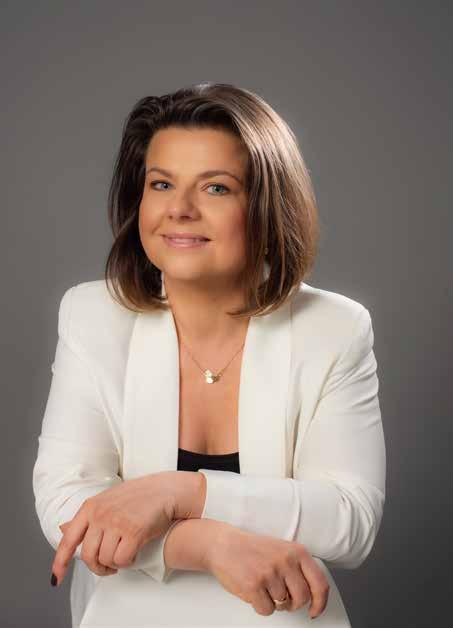
WBJ: At what stage of the road to the 5.0 revolution are we on? From your observations, are we ready for the full integration of human and artificial intelligence?
I believe that the Polish industry is mentally ready for the 5.0 revolution, but if we consider technology and the digitalization of businesses, we are still stuck in the 4.0 revolution, and sometimes even the 3.0 one. From month to month and year to year, we can see the
growth of innovation in areas such as the Internet of Things (IoT), automation, or robotics. However, it is still common that a human steps in when a computer fails. In some companies the economic aspect often plays a more significant role, and human labor is sometimes more profitable in financial terms. Additionally, it is easier to buy a modern machine than to find a properly trained employee to calibrate and repair it. The full integration of people with machines will take
54 APRIL - MAY 2023 WARSAW BUSINESS JOURNAL PRESS MATERIAL
time. It requires the education and training of human resources, and this is a time-consuming process. Evolution is happening right before our eyes, but the revolution is still some time away. Everything is moving in the right direction, but despite the goal-oriented attitude, we often feel a sense of resistance to change and fear that artificial intelligence will take away our jobs. Personally, I love change and actively promote innovation at ifm electronic. However, in this case, these changes will take time, an openness to action, and permission to make mistakes and take risks.
Is ifm electronic ready for the 5.0 revolution?
I don't consider our work in terms of further revolutions, which will eventually happen in one way or another. Our goal is to do our job as well as we can. I often feel that we all get breathless constantly chasing an ideal state, which in the VUCA world is rather impossible to achieve. Technology supports us, and we use it as much as we can. However, humans have to agree that technology not only supports us but also co-creates our reality. Sooner or later, we will have to start living in symbiosis with technology but for now, let's enjoy its benefits as much as we can, using the available resources.
What KPIs do you consider when assessing a company's readiness to enter the next level of the industrial revolution?
I am not a fan of evaluating anything through the prism of KPIs. Of course, metrics are helpful because they show the effectiveness of implemented processes, structures, positions, or solutions. But I shy away from evaluating a company's readiness "for tomorrow" through the prism of rigid metrics. It is more important to involve our team,
implement new ideas and experiment rather than just measuring and comparing indicators. I believe that it is the synergy in human activities that allows us to go to the next level in every area.
You mentioned that sometimes buying a machine is easier than finding a properly trained employee to fix it. Education is one of the challenges facing the human factor. It is certainly not the only one. Working with people allows me to observe their approach to new technologies. My team invariably amazes me with their skills, competence, and how they use digitalization. I think that if someone is open to new things, they
(and take) responsibility. In a changing world, these are essential to thrive.
Automation, robotization and digitization are already happening, but we are far behind world-class manufacturers in terms of Overall Equipment Effectiveness (OEE). They have an OEE of 85%, while we have a maximum of 65%. Where does this come from?
I believe the reasons for the lower efficiency of machines in Polish factories are due to the fact that we had a different start than most countries in the world. However, we are still catching up! Our engineers and maintenance staff are real diamonds, and I'm convinced that they are up to the challenge - whether it's keeping machines and equipment running, energy efficiency, or enhancing productivity.
How does ifm support the improvement of machine efficiency at its customers? As a supplier of systems and automation to industry, we can do what we do best: provide tools and solutions that support our customers’ decisions, turn their visions and ideas into tangible actions and help improve production performance. The rest is up to them.
can learn everything. Sometimes we don't want to get involved because we trust ourselves more than we trust machines. We don't know what role technology will have in a few years and whether it will sometimes want to take our place. Concerns in my opinion, are not valid, but I understand them. Among the competencies of the future, I would certainly mention the ability to act in situations of uncertainty, to cooperate with others, to be creative and to feel
Putting aside the issue of production itself, how do ifm's hardware and software solutions support sustainability? At ifm, we start from the premise that all participants in the supply chain must work together to take concrete steps towards sustainability. That's why we are already using AI tools to optimize profits and minimize losses in the industrial sector. For example, our moneo platform converts sensor data into digital information, enabling predictive maintenance of machines, avoiding unplanned downtime, and increasing the efficiency of the entire plant. Our technologies also allow early detection of serious damage, reduce unnecessary downtime, or
WBJ.PL 55
Sooner or later, we will have to start living in symbiosis with technology but for now, let's enjoy its benefits as much as we can”
enable real reductions in waste production. Given the nature of our products, we must feel a shared responsibility and support our customers' ESG activities. I don't see any other option.

What are ifm's development plans for the coming years? Are you going full steam ahead, or still proceeding cautiously due to uncertainties in how supply chains will evolve?
There is no reason to stay in limbo indefinitely. What is supposed to happen will happen, whether we proceed cautiously or not. Therefore, we are going full steam ahead! But after the recent crises, we are also weighing the risks and trying to balance them with a bit of prudence and reason.
Aleksandra Banaś has been the CEO of ifm electronic sp. z o.o since 2013 and has been with the company since 2004. She has dedicated many years of intensive work to the development of the company in the Polish market, and under her leadership, ifm has received numerous awards and distinctions. With a passion for innovative solutions in the industry, she is always seeking opportunities to connect the world of automation with the world of IT.
Since its establishment in 2004 with just four employees, ifm has grown significantly, now employing over 30 people and holding a crucial position in the Polish industrial automation market. The company specializes in developing sensors, controllers, software, and systems for industrial automation across all industries where automation is possible.
56 APRIL - MAY 2023 WARSAW BUSINESS JOURNAL
automotive industry food industry mobile machinery wind power industry machine tools steel and metallurgical industry
BIO
GAMING
Carbon Studio to create new VR game
New Connect-listed Carbon Studio has signed an agreement with Kepler Interactive to create a VR game for one of Kepler’s studios, based on an existing game released on other devices. The new game will be set in the “Warhammer: Age of Sigmar” universe and available on all major VR platforms.
Drago’s farm simulator at the top of Steam Wish List
Krakow-based Drago Entertainment's newly announced game, “Farm Simulator,” made it onto Steam's Global
Top Wish List just 11 days after its announcement. Drago Entertainment recently signed its first publishing agreement with Codebusters Studio for the game, which tasks players with turning an abandoned farm into a modern, ecologically sound operation. The game will feature humorous elements.
FinGames invest €10 mln in Polish game dev studios
FinGames plans to invest at least €10 million in Polish game development studios. The company plans to start raising capital from Polish and international venture capital funds in April this year.
“Polish game dev is growing
The Ministry of Finance warns against fraudulent e-mails about tax refunds

The Ministry of Finance warns against fake e-mails informing about tax refunds. In fake emails, the sender asks to scan the attached QR code to collect the tax refund. Opening links or attachments, scanning QR codes, and sending a reply to the sender is dangerous, the ministry warned. As a result, the user’s device may be infected with malware, which transfers data to unauthorized persons.
The ministry published an example of such a fake email. The message addresses the recipient as "Dear Citizen", and says that there is an application for an automatic tax refund for January-March 2023.
in double digits in every possible metric – from the value of sales, through the number of games released, to the number of new studios,” FinGames CEO Krzysztof Caruk said in a statement. So far, the company has raised PLN 10 million.
CLOUD
Hybrid cloud prevails in Poland
As many as 85% of businesses use two or more cloud platforms, and 25% use at least five different cloud providers, according to Deloitte’s “Tech Trends.” In Poland, the majority of companies prefer a hybrid cloud, with key systems still kept within an on-premise infrastructure.
Price and transparency are key when choosing cloud
As many as 54% of decision-makers choosing cloud solutions considered price to be the deciding factor for the decision on which cloud to choose, followed by a “well-tailored offer” (46%) and “transparent terms of service” (44%), according to a survey conducted by FOTC, a Google Cloud partner active in Poland and CEE markets.
Polish CFOs look to the cloud for savings rather than innovation
Nearly half (49%) of Polish CFOs are considering cloud solutions to increase operational efficiency. Lowering operational costs came as the second most important reason for employing cloud solutions, according to a recent Deloitte study “Where is cloud value? A Polish CFO perspective.” Only 29% of CFOs consider increasing innovation as the driving factor. Almost 70% of respondents expect financial and business instability over the next 12 months and seek flexibility and efficiency in cloud solutions in response.
ARTIFICIAL INTELLIGENCE
PKO’s AI voice assistant services 1 million clients
PKO Bank Polski reported that over 1 million customers have used its voice assistant in the IKO application. The assistant understands over 320 conversation topics, and PKO Bank highlights that artificial intelligence (AI) is increasingly being used in the bank for customer service and internal processes, as well as in risk assessment and CRM. The bank has 16 bots in total, which perform tasks in various areas.
WBJ.PL 57
Mechanization and robotization affect the replacement of physical effort in many branches of the economy, and artificial intelligence will replace mental effort, especially for tedious activities characterized by low productivity. But mechanization never invalidated the role of humans in economic processes, and neither will AI.
– Marcin Żuchowicz, CEO of the e-point
SHUTTERSTOCK
recent open letter to the tech industry from scientists and tech doyens (as well as one Twitter CEO), calls for artificial intelligence (AI) companies to put a break on their AI arms race. They say that if we continue funneling billions of dollars into training more sophisticated models, we may simply miss the mark when we develop a model beyond a narrow, specialist AI. A so-called general AI may be able to determine its own goals and means of achieving them. And could simply turn on us, its creators. Scary, but we’ve seen too many post-apocalyptic movies and TV shows for vague threats to have any real impact.
More tangible, short-term challenges they list include uncontrolled job automation (and a huge wave of unemployment as a result), AI bots spreading misinformation on a mass scale, and rampant fraud. We’ve already seen the first malicious uses of AI, such as a very recent attempt to extort ransom from a father by having AI mimic a distressed call from his daughter. Chilling, yes.
The points about a cautious approach to AI are valid, and ideally, we could all agree to take a step back, reassess and reevaluate our course. Ideally.
The thing is that historically there has been little room for idealists in the business world. Granted, some tech visionaries could be considered idealistic. Or maybe that’s the narrative they managed to spin years or decades after joining the exclusive club of ultra-rich philanthropists who cure malaria.
WHAT’S THE WORST THAT CAN HAPPEN?
ATHERE ARE TWO REAL PROBLEMS WITH STOPPING TECH GIANTS’ “FAST AND FURIOUS” RACE FOR THE AI HOLY GRAIL:
1. Revolutions generally don’t come gradually. They happen fast and disrupt industries (streaming services, social media, smartphones, search engines). Unless they fail to capture the market and fizzle out (NFTs, beta max, blu-ray) or crash spectacularly (dot coms, crypto). But once a tech revolution is underway, it is virtually impossible to stop it. The cat’s out of the bag. We now have LLMs (Large Language Models), such as ChatGPT, which can do remarkable things, for better or worse.
2. There is no economic incentive to let your competitors get to market first, especially if you’re trying to capture a burgeoning new segment whose value is yet to be determined. And corporations have a very clear fiduciary responsibility and a well-defined mandate: make your shareholders happy.
Recent moves by Disney and other tech and media giants leave little room for doubt about where the money is. As Fast Company reports, Disney, following in the footsteps of Meta, scrapped its metaverse project and is laying off thousands, gearing up for the AI chase instead.
BY BEATA SOCHA
58 APRIL - MAY 2023 WARSAW BUSINESS JOURNAL
Scientists and tech experts are warning of the dangers of funneling billions into training sophisticated AI models and calling for a more cautious approach.
lthough the language model used by ChatGPT is the biggest language model created so far, the technology behind it is not revolutionary. The neural network architecture using so-called "transformers" ("GPT" stands for Generative Pre-trained Transformers) was invented by Google researchers in 2017, and since then, it has been used successfully in hundreds of Large Language Models. However, ChatGPT was a great marketing success. And it has made many people think more about applying AI in various fields, including business.
AI is a buzzword for some companies to improve their image as modern and innovative firms to attract investors and improve their valuations. Or they use AI as a marketing tool, hoping that putting "powered by AI" in their product description will boost sales.
Of course, if it is wisely and carefully used, artificial intelligence can bring tangible business benefits not only by reducing human effort and supporting people in performing their tasks. Or even completely replacing people in some standard, repetitive activities. Many companies have started using AI to improve and automate their processes, for example, in marketing, sales, accounting, HR, or customer service.
Developing a state-of-the-art Large Language Model requires terabytes of text data and a cluster of thousands of graphics processing units (GPUs) working for several months. Training requires as much energy as a small town uses weekly. The cost of training can run into millions of dollars. However, many pre-trained Large Language Models are available as open-source software that can be downloaded from the Internet and, after some fine-tuning, can be deployed for many uses, including commercial purposes. Moreover, in many applications, the AI solution can be much simpler.
ABEYOND THE BUZZWORD –
WHAT ARE THE PROS AND CONS OF CHATGPT?
ChatGPT grew to 100 million users in just two months, setting a new record for the fastest-growing internet application. But experts caution against believing all the hype.
BY JACEK KRAWCZAK
Implementing an AI system usually starts with a proof of concept that verifies both the technical feasibility and business benefits. It also helps to decide the scope of the final deployment. A successful AI system does not need to be perfect or completely replace humans in a specific area. It is pretty common for people and AI to work side by side. For
What is dangerous about AI are the unrealistic expectations, especially at the current stage of AI development. An AI system may work relatively well in most cases. However, in some cases, its operation may become unpredictable. Therefore, its recommendations should not be the sole determiner of important decisions.
example, in accounting, the AI system analyzes the texts of an incoming invoice and assigns the correct account, cost center or tax code based on learned invoice posting patterns in the past. This approach can work for most recurring invoices, but in exceptional cases where the system cannot predict where to post the invoice based on historical data, the invoice is routed to accountants.
An AI system deployed to production should be closely monitored and when its performance diminishes, it should be re-trained or decommissioned. And this needs to be planned well in advance. Artificial Intelligence is just a tool. A complex tool that can be very helpful if correctly used. But it can be harmful if applied in a wrong way. or not supervised closely enough.
WBJ.PL 59
SHUTTERSTOCK (2)
CEE Business Retreat

(6-7 June 2023, GrandHotel Tiffi, Poland)
By invitation & referral only.

For top decision-maker level investors, developers and lenders. Places are limited. Inquiries to be sent to admin@entralon.club
Professor at Kozminski University, author of "Europe’s Growth Champion: Insights from the Economic Rise of Poland”

Prof. Marcin Piatkowski is Lead Economist at the World Bank in Washington DC. Previously, he was Chief Economist of PKO BP, economist in the European Department of the IMF and Advisor to IMF's Executive Director. He also served as Advisor to Poland's Deputy Premier and Minister of Finance. He was a visiting scholar at Harvard University, London Business School and the OECD Development Center.
Marcin will present: “The Global Polycrisis: Key Trends, Challenges and Solutions”

The world is going through an unprecedented combination of multiple crises—high inflation, energy price shock, Ukraine war, GVC restructuring, debt crises, decoupling and climate change—which make economic policy much more challenging and economic outcomes much less predictable. The polycrisis has strengthened some of the ongoing global trends and given rise to new challenges and opportunities. Luckily, there are solutions that can help minimize the future risks and maximize the benefits of new opportunities, for Poland, Central and Eastern Europe and the world as a whole.
MARTIN HEALEY, ON THE REAL ESTATE TRENDS

Managing Director, Real Assets at CPP Investments:
Martin Healey delivers insights and actionable advice to Real Assets’ investment committees and transaction teams on issues impacting long-term investment performance. He serves on global investment committees for real estate. Martin joined the Real Estate investing team in 2005, founded the Private Real Estate Debt group in early 2010 and established the Listed Real Estate program.
WILLIAM ALBERQUE ON GEO-POLITICS
Director of Strategy, Technology and Arms Control at IISS (International Institute for Strategic Studies)
William Alberque is Director of Strategy, Technology and Arms Control, focusing on preventing the proliferation of nuclear weapons, weapons of mass destruction and related delivery systems, as well as risk reduction and arms control at IISS, one of the world's leading think-tanks. William previously served as the director of NATO’s Arms Control, Disarmament, and WMD Non-Proliferation Centre (ACDC).
Svetlana Fedosova, Founder of Entralon Club, added:


'It is an honour to have been entrusted with organising this Retreat and to have been supported by our Advisory Board. We are aiming to convene the very top investors, developers and lenders active in the CEE Real Estate landscape. Our special speakers from London, Washington and Berlin will bring a global perspective that will enrich the discussion among participants on the foreseeable future of the CEE real estate market.
www.entralon.club/ceeretreat
PROF. MARCIN PIATKOWSKI ON MACRO-ECONOMICS
Life + Style
DISCOVERING THE ARTISTIC WORLD OF PANI JUREK
Magda Jurek’s passion for materials and unique design approach transforms everyday objects into works of art

WBJ.PL 61
Pani Jurek, founded by designer Magda Jurek, blends fine arts, craft, and design. Products are created according to her imagination rather than a business strategy. Each product is personal and matures over time. Jurek's fascination with materials, particularly ceramics, is evident in all of her products. The brand's social projects and non-commercial initiatives often produce usable products that are designed to respond to their surroundings and users.
At Pani Jurek's small Warsaw workshop, local craftspeople work under her watchful eye, ensuring a high standard of craftmanship. Due to the unique nature of the design and manufacture process, products become lasting interior elements. The process ensures an element of surprise; each object is the result of a specific person's unique experience, talent, manual skills, and attention.
Pani Jurek's studio is committed to using local resources, with small non-ceramic pieces subcontracted to small craft workshops, and wooden objects made at Square Drop, a renowned furniture preservation studio. Her studio's idyllic location among the apple orchards outside Warsaw facilitates the concentration necessary for artisanal work.


Magda Jurek's approach to design is about building compositions, with her objects serving as signs, sculptures, or installations. She explains, "My projects are personal; they combine several threads, which at the right moment or under some impulse, come together." Pani Jurek's products are not only aesthetically pleasing but also interactive and usable, with each object telling a unique story and bringing an essential human touch to the craft.

62 APRIL - MAY 2023 WARSAW BUSINESS JOURNAL DESIGN/WINE
PHOTOGRAPHS THIS PAGE AND PREVIOUS PION STUDIO
Varietal of the Month by Wine Expert
Peter Pulawski
FEMALE SUPERTASTERS!
Let's accept once and for all that when buying wine for women, semi-dry or semi-sweet pleasant and mild wines are neither required nor necessary.
Working 21 years with Polish wine consumers and customers allows me to state unequivocally that there is no such thing as "woman's wine"!
Several universities have discovered that women, on average, have 43% more cells in their brains' olfactory bulbs than men. When counting neurons specifically, the difference reached almost 50% in favor of women. Also, Charles Wysocki, Ph.D., revealed that with six to ten repeated exposures, women (of reproductive age), not men, could increase their sensitivity to an odor by 1,000 to 10,000 times. Research at Yale University Linda Bartoshuk Ph.D. has shown that about 35% of women but only 15% of men are supertasters. Supertasters have up to four times as many tastebuds as non-tasters. Women have the same diverse palate and tastes as men when it comes to wine. Customers of the Dobrewina.pl chain buy dry wines in about 95% of their purchases - for themselves, their relatives, or their clients.
So my impression is quite the opposite: it is men who are more willing to buy and drink milder wines with more or less sweetness!
Smoked/smokedbacon
WHEEL OF AROMAS AND FLAVORS
dobrewina.pl offers an ‘Aroma Wheel’ (Koło Aromatów) - an original tool to recognize and describe wine aromas and flavors - and organizes workshops teaching the world of wine aromas in practice. Please check the link in the QR code above.
Versatile white wine for the Spring Season
The oaked Pavillon des Trois Arches Chardonnay from Languedoc is strongly recommended as an accompaniment to Polish as well as Mediterranean food. It will go well with yellow and white mould cheeses, cold-cut meats, poultry, pâté, traditional vegetable salads, etc. The aromas from the aroma wheel, which can be associated with this chardonnay, are: pear, apricot, melon, cream, butter, vanilla and oak – with hints of Earl Grey, orange peel, fig preserves, honey, toast and toffee. (Aromas noted with above)

WBJ.PL 63
(Mis)conceptions about men's versus women's taste in wine.
Orange/Grapefruit Lemon/Lime Vitamin C, Ascorbic Acid Pear Apple Apricot/Peach Mirabelle WhiteGooseberry Grapescurrant TuttiPassionPineapplefruit/LycheeStrawberryRaspberryfrutti /Strawberry Blackberry Cherry/CherriesPlumBlueberry/Blueberry Rhubarb Black lilac Banana Jasmine Violet RoseLavender/Lily Red/green peppersTomato/CauliflowerMint/MelissaRosemary/DillThyme/SageFreshlycutgrassHay/BlackTobaccoEarlEucalyptus/CamphorOreganoTea Grey/Bergamot FlintGranite/Wetgravel Pottingsoil Petroleum/Tar Yeast/Soy Baguette Yogurt/Cream Butter Stewedfruitcompote OverripefruitOnion/GarlicRottenegg/Burntrubber Alitmatch Caturine Forest undergrowth Ranciooxidized butter and nuts Caramel Truffles/MushroomsChocolateMusk/LeatherSweatySaddle/The Cowshed Mustywet cardboard WetdogOxygenatedapple
Melon/Papaya BlackcurrantRedcurrant /Chokeberry Olives Linden/Acacia Orange peel Wax/Saffron Raisin/Fig Driedplum/ApricotHoney ToastCoffee Whiskey/ToffeePine Cedar-boxwoodSandaltreeOak BourbonVanilla/VanillaClove/CardamomNutmegLiquorice/AniseCinnamon/GingerBlackPepper/ChiliCoconut/Almond Hazelnut Overripefruit Touchwood Tropical fruits Redfruits Black fruits Other fruits Flowers VegetablesFreshherbsDriedherbs Other Orchardfruits Cytrusy Mineral Yeast Fortified wines Milk Red wine CorktaintOxidationCookedwineVolatileacidity Sulfides Brettanomyces Barrel Wood Spices Nuts Botrytis Appassimento Pleśnie Fruitred Vegetative Fermentation Earth Vinification Wood aging Lateharvest Fruit- wines white wines faults
Bandage/Rancidfat
©Dobre Wina Sp. z o.o. 2023
EVENTS
The WBJ relives or looks forward to the most important events in the world of business and economy
THE 8TH EUROPEAN CONGRESS OF LOCAL GOVERNMENTS HAS BECOME HISTORY. TIME FOR A SUMMARY
The European Congress of Local Governments is one of Poland's leading conferences focused on local government. Its aim is to create an independent platform for discussions on the key challenges facing Poland and Europe. The 8th European Congress of Local Governments attracted about 2,000 guests from 33 countries.
This year's Congress had a substantive program consisting of over 170 events, including plenary sessions, workshops, conversations with well-known figures of social, economic and political life, and book presentations. The events took place on 13 thematic paths, including Economy, Self-Government of the Future, Environmental Protection, Business and Management, Finance, and Society.
The business community was represented at the Congress by companies such as OX2, Play, AstraZeneca Pharma Poland sp. z o.o., Bank Gospodarstwa Krajowego, Pfizer, PZU Zdrowie, Polish Development Fund, Signify, Pessa, POLREGIO, PKN Orlen and ARP e-vehicles.
One of the guests of the 8th European Congress of Local Governments was Bert Häggblom, President of Åland Islands-Lagting (Finland), who thanked all Poles for their amazing support during the war in Ukraine at the plenary session.
During the Congress, there were many meetings with outstanding experts, scientists, and journalists, including Andrzej Zybertowicz, Bronisław Wildstein, Marek Budzisz, Marcin Solarz and Andrzej Krajewski.
On 6-7 March 2023, the 8th European Congress of Local Governments took place at the Gołębiewski Hotel in Mikołajki. The motto of the Congress was: "New Solidarity for a New Era."
Finally, the Special Prize Poland-Ukraine Common Cause was awarded during the 8th European Congress of Local Governments in the categories of Man, Local Government, Non-Governmental Organization, and Company.
10TH INTERNATIONAL CONGRESS OF FAMILY BUSINESSES FOCUSES ON THE FAMILY FOUNDATION ACT


The 10th International Congress of Family Businesses took place in Poznań, Poland, on 20-21 March 2023. The event, organized by the Institute of Family Business, focused on the new legislative solution, the Family Foundation Act, which will be available to family businesses after 22 May 2023. The conference theme was "Family Foundation - Between Hope and Reality."
During the conference, experts from the Institute addressed topics related to the new legislative solution. All panel discussions, workshops, and lectures were dedicated to closely examining the proposed solution. With a new format enriched with expert summaries and a discussion forum, participants could ask questions, engage in discussions, and talk about current situations, issues, and challenges facing entrepreneurs.
The new legislative changes will require a thorough understanding of the perspective of family entrepreneurship and the laws governing the company and family. To address this, the Institute premiered the publication "Family Foundation for Multigenerational Family Businesses." The book is the result of the cooperation between Institute experts Dr. Adrianna Lewandowska and Professor Jacek Lipiec, with a team of lawyers, Michal Gniatkowski, Piotr Andrzejczak, and Joanna Wierzejska.
The book provides a practical guide for family businesses that want to consider starting a family foundation but need help knowing where to begin. It covers various aspects of family foundations, such as their purpose and mission, management structure, statutes, procedures, and legal and tax issues. In addition, the publication is a personalized, informative guidebook for family businesses, including expert comments and the merits of preparing to establish a family foundation.
Polish family businesses have eagerly awaited the Family Foundation Act, and the Institute's efforts to provide accurate, relevant, and timely information about this new legal solution have been well-received. With the book's premiere and the congress's new format, participants left with a wealth of knowledge and the tools needed to consider and establish a family foundation.
64 APRIL - MAY 2023 WARSAW BUSINESS JOURNAL PRESS MATERIAL
TRANSFORMATION OF URBAN TISSUE (BROWNFIELD-TYPE SPACES)
we care about
CREATION OF SPACES THAT FIT INTO THE 15-MINUTE CITY CONCEPT
LOCATING INVESTMENTS IN DIRECT VICINITY
GREEN CONSTRUCTION – ALL OUR INVESTMENTS RECEIVED THE HIGHEST LEVEL OF LEED PLATINUM
CARE FOR DEVELOPMENT OF THE REGION AND LOCAL COMMUNITY
ADJUSTMENT OF OUR OFFICES TO THE NEEDS OF THE DISABLED
TORUS.PL





Awards • People • Thought-Leaders • Entertainment ESG: Where Sustainability and Success Spin in Harmony!
CEEQA 2023 Report





CEE & SEE REAL ESTATE
INDUSTRY QUALITY AWARDS In black and white.
GALA / ESG CHAMPION AWARDS

Dear valued guests,

We are thrilled to announce that the CEEQA23 Gala is fast approaching, taking place on June 14th at Wyscigi in Warsaw. For the past 20 years, the CEEQA awards have been organized with unparalleled integrity and trust, earning the respect of the market and becoming one of the major gatherings of senior industry professionals in Europe.
This year’s gala promises to be an unforgettable experience, offering the highest caliber business mixing, hospitality, and production, including an elegant champagne reception and dining, and the legendary no-limits afterparty that CEEQA is known for. But that’s not all - we have plenty of new surprises and value drivers in store for our guests.
The CEEQA awards have become a must-attend event for the CEE & SEE real estate community, and for good reason. The unshakeable integrity of the judging and results, coupled with the quality and diversity of award entrants covering 18 country markets in the region, make it a showcase annual event and the most senior annual gathering of leaders. All aspects of the entry and judging process are closely supervised by the globally trusted consulting firm PwC, ensuring that the CEEQA awards remain relevant and valuable to the real estate community.
We are also excited to announce the new ESG Champion Awards, which expand the focus of CEEQA’s longstanding Green Leadership Awards to include social responsibility and sustainability, as well as corporate governance. We are committed to recognizing and measuring not only environmental responsibility, but also business performance and accountability, making the CEEQA awards even more comprehensive and impactful.
And let’s not forget about the entertainment - CEEQA’s star act roster boasts the likes of Morcheeba, Boomtown Rats, Gloria Gaynor, and Macy Gray in recent years, and this year’s gala guests have something to really look forward to! Heather Small, one of the seminal British voices of the 1990s as part of M People, will be performing hits such as ‘Moving On Up,’ ‘One Night In Heaven,’ and ‘Search For The Hero,’ alongside an array of colorful entertainment features and performances that make up the CEEQA formula.
The Q in CEEQA stands for Quality, and we are committed to delivering a high-quality, unforgettable experience for our guests. We look forward to seeing you at the CEEQA23 Gala and creating unforgettable memories together.
Sincerely,
Richard Hallward & the CEEQA Team

ESG, THE BUSINESS CASE
With the EU’s deadline for ESG compliance looming ever closer, the real estate industry sets an example for all.


No longer a novelty or a “nice to have,” the acceptance, understanding, and incorporation of a coherent ESG strategy is a global business essential – and now even more so given the EU’s looming deadline for ESG compliance. Often at the vanguard, the real estate industry has responded to this shift in mentality in a manner that has been more than just adoptive -- it has been innovative.
However, questions remain. Regarding the bottom line, doubters have asked if the short-term costs relating to ESG compliance can ever tangibly translate into long-term profitability. Saliently, concerns likewise exist about the validity of ESG’s potential to truly shape the planet for the better. In other words, can our commitment to ESG yield results?
Certainly, across the industry, the enthusiasm and sincerity with which ESG has been embraced is
to be applauded and demonstrates the seriousness with which the topic is being treated.
“For years, we have been implementing our sustainable development strategy ‘Go Earthwise with Panattoni’,” says Emilia Dębowska of Panattoni. “As the first developer to embrace certifications like BREEAM, we set a new direction for industry expectations. Now, investors, funds, and financial institutions widely require such certifications from developers, recognising
4 CEEQA REPORT 2023 WARSAW BUSINESS JOURNAL
COVER STORY
Stay ahead of changes and become a real estate market leader
We offer tailored services throughout the property lifecycle, which facilitate preparing investment and divestment processes, allow optimal business decisions and foster value creation. We have knowledge and experience of all the major segments of the commercial real estate market (retail, office, warehouse and leisure) as well as the residential real estate market, including PRS.

Mergers & Acquisitions
Transaction Services
Lease management
Business Analytics Accounting
Tax Compliance
Real Estate Law
pwc.pl/realestate
the importance of sustainability.
“Furthermore,” adds Dębowska, “customers benefit from lower operating costs associated with certified facilities, highlighting the far-reaching positive impact of Panattoni’s trailblazing commitment to sustainability and environmental responsibility.”
The visible result of these actions is over 10 million sqm of Panattoni’s certified space across Europe and another 6.5 million under assessment – currently at BREEAM Excellent level. By the end of 2022, the developer had achieved an Excellent level in 18 investments, and this year, another six facilities have already joined their ranks. The developer’s first Polish investment – Panattoni Park Szczecin III – also received a certificate at the
highest possible level of Outstanding in February this year.
Previously, this level was achieved by one of the developer’s investments in the Czech Republic - Panattoni Park Cheb South. Currently, construction is underway for another three investments there, which are also expected to reach this level, as well as ten other projects – with a total area of 420,000 sqm - which will be certified at the Excellent level. Panattoni’s portfolio has also expanded to include the first highly energy-efficient factory for Danfoss Poland, fully-powered by renewable energy sources, where all technical systems of the building are electrified, and waste heat from production processes is used for heating buildings and water.
The commitment to ESG has resounded across the sector. “MDC2 was set up with ESG as a core pillar of its business activities,” says Jeremy Cordery of MDC2. “It’s in our DNA, and we are 100% committed to delivering sustainable buildings through a coordinated approach of ‘E’, ‘S’, and ‘G’.”

Such pledges have been echoed across the sector. “Long-term and complementary ESG activities are of strategic importance for our business and are in line with Ghelamco’s philosophy,” says Jarosław Zagórski. “We are always looking for ways to make our projects even more ecological, innovative, and comfortable, and that’s added to our sense of responsibility for our common good, which is the environment,
According to Cushman & Wakefield, 4.4 million sqm of warehouse space has been delivered since the beginning of 2022, a 40% y-o-y increase and an all-time record for the Polish market. In the next five years, the industry will be radically transformed by automation and smart technologies.
“At CTP, we don’t want to adopt a passive posture – we already offer future-oriented facilities that can be fully automated when required. By 2025, CTP plans to install sufficient photovoltaic panels (PV) on the roofs of our buildings capable of producing up to 50MWp. This power output equates to about 10,000 typical installations on residential houses and translates into an annual reduction of 23,000 tons of CO2, while saving 11,500 tons of coal,” explains Bogi Gabrovic, Deputy Country Head at CTP in Poland.
Poland is one of the key markets in the CTP Group’s portfolio. In 2023, the country is set to become the fourth largest warehousing market in Europe, with over 30 million sqm lettable area. CTP is investing in the country, illustrated by its 2022 acquisition of 2.5 million sqm of land and already has over 600,000 sqm under construction slated for delivery this year.
The company’s latest project are able to fulfill CTP’s aims. Last month, the company announced the launch of its first project in northern Poland, CTPark Gdańsk Port, which will provide nearly 119,000 sqm of lettable area in a key location for global supply
chains. This new park is located within the Pomeranian Investment Center adjacent to the only deep-water terminal in the Baltic Sea region, which directly receives ships from the Far East. The first phase of the project is scheduled for delivery in the fourth quarter of this year.

6 CEEQA REPORT 2023 WARSAW BUSINESS JOURNAL COVER STORY
READY FOR THE FUTURE
CTP’s Development Strategy in Poland
CTPark Gdańsk Port
CTP A5 2023_04_04_WBJ v5.indd 1 05.04.2023 11:06
Bogi Gabrovic Deputy Country Head, Poland
but also responds to the future needs of business.”
At Revetas, Katerina Nesitova is equally frank when addressing the company’s activities and ESG policy. “ESG isn’t going to go away,” she says, “but I think, generally speaking, the topic has come to be associated with positive outcomes – not just by companies, but by society as a whole. So, yes, I am surprised by the speed with which ESG has come to influence every aspect of how firms operate, but I mean that in a good way. ESG is here to stay, and we’re more than up for the challenge.”
In the case of Revetas, the ultimate goal has already been expressed in black-and-white terms: a portfolio that achieves net carbon neutrality by 2040. “Everything we do and implement or plan is in line with this ambitious goal,” says Nesitova. “As a company, we can enhance the long-term sustainability of our investments and deliver a better outcome not just for our investors but for the community within which we operate.”
Applying such a far-sighted approach is fundamental when understanding the mechanics of ESG and unlocking its benefits. Per indepth reports previously released by PwC, inaction and a “business as usual,” attitude will likely lead to value destruction as new legislation comes into force. Moreover, with peers making progress on ESG matters and consumer, employee, and investor expectations also changing, value erosion can be seen as an inevitable outcome.
On the other hand, those following “a sustainable transformation” stand to gain copious advantages in the long run: customer demand for ESG-driven products and companies should translate into top-line growth, whilst reductions
in emissions will naturally lead to reductions in costs. Regulatory compliance, meanwhile, dovetails towards tax credits and subsidy eligibility (not to mention the avoidance of industry penalties). Moreover, investment in green assets should translate into asset optimization, whereas the creation of purpose-driven workplaces should
spark an increase in productivity.
CTP’s business model has shown how ESG commitments can be successfully harnessed in many respects. “For many years, ESG has been a vital dimension of CTP’s business,” says Adam Targowski. “Our strategy is founded on a long-term approach where we aim to build and manage properties of
Higher returns through bespoke solutions.
As your partner in national and international markets in real estate business, we are the experts for your bespoke nancing solutions, we give your project the drive it needs to succeed – competently, reliably and over the long-term.


WARSAW BUSINESS JOURNAL CEEQA REPORT 2023 7 The Flow Building € 82,200,000 Office Poland LIXA € 60,000,000 Office Poland Chmielna 89 € 475,000,000 Office Poland Varso Place PLN 230,000,000 Poland Residential Portfolio € 190,000,000 Office Czech Republic Dock I-V € 105,300,000 Office Czech Republic Churchill Square € 129,000,000 Poland Logistics Portfolio € 79,000,000 Office Czech Republic Main Point Pankrac
Values with impact. Mixed Use Czech Republic 2023036802 Helaba Motiv PA Immobilien CEE engl 114x166mm CEEQA23 special report indd 1 2023036802_Helaba Motiv PA Immobilien CEE engl 114x166mm CEEQA23 special report.indd 1 31 03 23 10:59 31.03.23
the highest quality and efficiency, meeting current demands and those of tomorrow.
“As owners, we prioritize energy efficiency and photovoltaics to minimize occupancy costs. Additionally, as a long-term owner and industrial park developer, we place great importance on being a good and engaged neighbor. In collab-

oration with local municipalities, we’ve undertaken several initiatives to support education and enhance infrastructure. We believe that such initiatives are essential for the overall progress and prosperity of the community.”
Crucially, it has become abundantly apparent that ESG is a fluid creature in a state of constant
development – how firms adapt to changes, external pressures, and force majeures is critical, and to some extent, the lockdown era can be seen as a watershed moment.
“COVID reshaped expectations as to our working environment,” says Panattoni’s Emilia Dębowska. “Our focus on employee well-being ensures that our facilities remain attractive, safe, and sustainable in the post-pandemic world. By upgrading certification to BREEAM Excellent level, we’ve ensured that our facilities provide, among other things, optimal air quality, acoustic and thermal comfort, and enhanced lighting to promote a healthier working environment.”
Panattoni has even gone so far as to create pocket parks around their investments while planting thousands of trees and creating substantial wildflower meadows. “These solutions directly contribute to the overall health and satisfaction of employees and illustrate our commitment to a sustainable and people-centered approach to benefit the well-being of our employees, customers, tenants, communities, and other stakeholders,” adds Dębowska.
Yet how exactly should industry players measure their ESG policies’ success? For all, the results game has taken on a multi-faceted style. “At MDC2, we have a 100% staff retention rate, and our team believes in working to a higher standard to deliver better quality, demonstrably,” says Jeremy Cordery. “We are undertaking our company and asset baseline assessments and engaging our team in our materiality assessment. We’re also building the highest-rated BREEAM Outstanding building in Poland. Higher rated buildings have a higher value in the eyes of
8 CEEQA REPORT 2023 WARSAW BUSINESS JOURNAL COVER STORY
our investors, possibly by up to 50 bps when compared to lower-grade projects, and investors are actively seeking to boost their portfolio ratings and are starting to pay for this through better yields.”

Such a defined approach is in step with others. “We’ve implemented a set of KPIs that cover all relevant ESG areas,” says CTP’s Adam Targowski. “Our KPIs focus on carbon footprint reduction, renewable energy production, water conservation, accessibility, social engagement, diversity, code of conduct training, and other important areas. By measuring our performance against these KPIs, we ensure that we are meeting our ESG commitments and making progress towards a more sustainable future.”
By doing so, CTP has followed a holistic strategy. “We have been committed to this approach from the outset, and now we are focused on institutionalizing ESG within our organization,” continues Targowski. “We believe that renewable energy production presents a compelling business opportunity, and we’re continuing our investment in developing our capabilities across all our markets. By aligning our ESG goals with our long-term business strategy, we aim to create value for our stakeholders while contributing to a sustainable future.”
If anything, judging ESG performance has become an intricately delicate affair, a point underlined by Ghelamco’s Jarosław Zagórski. “We measure our ESG achievements both through real, mea-
surable effects and image-related ones. Thanks to our ultra-modern, energy-saving systems, we’ve already reduced the energy demand in Warsaw Unit by up to 30% compared to competing office skyscrapers. In addition, thanks to the use of energy from our photovoltaic farms, CO² emissions for our buildings throughout their life cycle are to be reduced by over 50%. Specific actions taken by us as part of the ESG strategy also have their image effect, which we have witnessed by way of how often we have been invited to various types of ESG events, asked for expert comments on this topic, and also received awards for achievements in this field.”
Visible factors, of course, have remained central to any assess-
CUSHMAN &
WAKEFIELD
WARSAW BUSINESS JOURNAL CEEQA REPORT 2023 9
A-23-01 ceeqa hal page.indd 1 31.03.2023 17:31:07
As a global leader in commercial real estate services, we make the most of every opportunity life offers - for our people, clients, communities and planet. With nearly five billion square feet of property under management and 50,000 employees in 60 countries, we make an impact around the world. Explore more at cushmanwakefield.com.
ment. “We measure the success of our ESG policies through a combination of key performance indicators and external validation based on building certification, which signifies adherence to strict environmental standards,” says Panattoni’s Emilia Dębowska.
“By consistently analysing data relating to our certifications, we can measure our progress and make ongoing improvements. This data-driven strategy thus enables us to effectively assess and enhance our ESG performance. For example, our certified buildings result in a power consumption reduction of up to 60% and savings of at least 50% in energy and water usage, which has translated into a reduction of approximately 280 tons of CO² emissions per year.”
Admirable as these accomplishments have been, one of the more encouraging elements is the creativity it has fostered. Not content with simply doing as others have done, the real estate segment has sought to actively lead by example.
At MDC2, for instance, the firm has introduced a company-wide holiday in the first week of July in addition to their annual leave allowance. “We also have a ‘million for a million’ policy where we put €1 million on the table each time we build one million sqm of space,” says Jeremy Cordery.
As expected, environmental solutions have also been emphasized by industry leaders. “We announced a ground-breaking project to build photovoltaic farms with a total capacity of 10 MW,” says Ghelamco’s Jarosław Zagórski. “We strive to use the energy produced from renewable sources to power entire office buildings, both ongoing investments and our own office space. The innovations we use that distinguish Ghelamco
from the competition also include a highly energy-saving Building Energy Management System, Signal OS operating system for buildings with their own applications, and anti-pandemic solutions. As developers, we want to achieve full energy neutrality by 2025.”
Panattoni are equally emphatic in their green crusade, something manifested by way of the firm’s ongoing campaign to reinforce all roofs with photovoltaic installations. “We’ve already adapted 1.5 million sqm of roofs in Europe, and we have another several hundred thousand square metres in progress,” says Dębowska. “Another innovative practice is equipping our
scheme. The smart energy management system – connected to a battery – ensures that surplus solar energy is temporarily stored and made available when the demand for energy exceeds its supply.
Every bit as impressive has been the degree to which related industry segments have also broached the ESG topic, whether banking or insurance. David Yearn of REassurance says: “ESG has been a welcome addition to the conversation regarding insurance, and the focus upon renewable energy projects, environmental impact assessment, water drainage, and pollution are all areas we have seen a rise in enquiries.”
Continuing, Yearn muses that this will only continue in the future. “Specialist insurers are adapting and developing new products. I fully expect that as new taxonomy regulations come into force from 2024, we will see more evolution with regards to insurance products for transactional risk in real estate.”
facilities with furniture from the wind turbines, meaning that not only do we promote renewable energy sources but also support their recycling efforts as well.”
Solutions for green energy are going even further. Last Autumn, in the Dutch town of Heerenberg, an innovative system was installed on a Panattoni building covering 24,000 sqm, which combines solar panels with an energy storage system operating in an off-grid
Tellingly, he is not alone in spotlighting the increased attention being given the “S” and “G” of ESG. “These are often overlooked when the subject is discussed, but socially the team at REassurance is committed to best practice and social fundraising, and for ‘G’, we operate in a regulated industry, so governance is a large part of our daily lives.”
Such thoughts are in line with those of Peter Klopf of Erste Group Bank. “We are aware that as a bank, all our actions also have an impact on the environment, as well as on the social cohesion of our societies,” he says. “This starts with the financial services we offer our retail and corporate clients and includes how we run our business.
“Due to the enormous negative effects of the climate crisis on the
10 CEEQA REPORT 2023 WARSAW BUSINESS JOURNAL COVER STORY
THIS DATA-DRIVEN STRATEGY THUS ENABLES US TO ASSESS AND ENHANCE OUR ESG PERFORMANCE EFFECTIVELY
environment and people, we are focusing intensively on supporting the green transition in addition to continuing our efforts towards inclusiveness in society – we firmly believe that Erste Group’s economic success in our region can be sustainable only if the green transition is successful and social justice is advanced. Therefore, these two dimensions associated with the region’s long-term prosperity are perfectly aligned.”
The swiftness with which ESG has come to dominate dialogue has been striking, but rather than elicit a cloudy and muddled response, we have seen the market’s leading players rise to the plate. Of course, while no crystal ball exists to forecast what happens next, it can be assumed that the all-encompassing prominence of ESG will increase only further.




“For buildings, at the time of writing, the emphasis remains squarely on the ‘E’ of ESG,” says Richard Hallward, founder of CEEQA.













“However, it is probably true to say that a building demonstrating the highest levels of cutting edge innovation and standards is the reflection and embodiment of a culture of change as well as the change itself. In short, green building certification still matters, but it’s not the only thing.
“CEEQA has long championed intel and advocacy for environmentally sustainable buildings and business since its first Green Debate in 2008, from which its long-standing ‘Green Leadership’ awards emerged. Of course, only the test of time will tell if the ESG Champion Awards can surpass CEEQA’s long-standing awards for Green Leadership as the barometer, and an accurate measure, of all-around sustainability, but the thinking is, they probably will.”


We see the big picture and manage the details that are necessary to develop commercial real estate projects all over Central and Eastern Europe. Erste Group offers financing solutions for your visions across the entire real estate value chain.

Time to believe. Time to invest.

www.erstegroup.com/cre







WARSAW BUSINESS JOURNAL CEEQA REPORT 2023 11
new perspectives on real
Take
estate financing.
CEEQA 2022 Lender of the Year
Kinga Barchon
Partner, PwC Polska
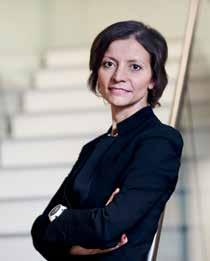
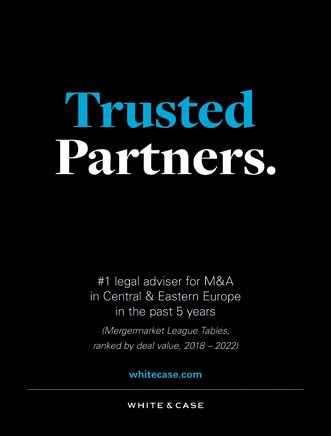
Going Green in Poland: How Sustainable Practices Benefit Businesses

Adoption of sustainability strategies among Polish companies is driven by multiple factors. We asked the CEOs in our CEE Survey about ESG and discovered the following:
• 45% of CEOs in CEE (40% globally) believe their companies will not be economically viable in a decade if they continue with business as usual.
• CEOs both in the region and globally expect some degree of impact from climate change in the next 12 months: primarily in their cost profiles (46% expect a moderate, large, or very large impact), followed by supply chains (43%) and climate-related damage to their physical assets (17%).
Co-authored
with Wiktor Witkowski, Senior Manager, PwC
Polish companies from various sectors, including fashion, manufacturing, and real estate, have embraced sustainability as a crucial strategic direction.
• 11% of CEOs in CEE are concerned about climate change in the next 12 months - a significant slip on the list of threat priorities due to the rise of other immediate threats.
• 48% of CEOs in CEE said that the transition to new energy sources would
Outstanding projects. Outstanding financing.
With a high level of expertise across all functions of the commercial real estate financing process, a cross-border approach and close cooperation with financing partners, pbb realises complex commercial financings. With a powerful team, we are your partner for real estate investments and real estate developments.
Real estate finance as unique as your real estate project.
pfandbriefbank.com
12 CEEQA REPORT 2023 WARSAW BUSINESS JOURNAL EXPERT
OPINION
impact their business in the next ten years, substantially more than the 37% of global leaders who foresee this effect.
• 46% of business leaders in CEE (34% globally) plan to invest in alternative new energy sources in the next 12 months.
Regulators and business benefits drive the widely expressed view on the need to adopt ESG initiatives. We list a few of them below:
1. Cost savings through technology:
• In 2022, LPP, the largest clothing company in Poland, implemented intelligent warehouses, reducing picking paths by up to 30% and cutting energy costs and carbon emissions proportionally. In addition, this is estimated to have decreased warehouse logistics costs by more than a third.
• Until 2021, Nestlé Poland reduced water consumption in production plants by 18% per ton of product, saving 4 million liters of water annually and significantly lowering operational costs. They achieved this through closed-loop water piping technology, AI algorithms, and rapid detection of faults and leaks.
2. Tapping into new sustainable revenue streams:
• Investing in sustainable sectors can lead to unprecedented growth. For instance, between 2020 and 2022, plant-based food sales in Poland surged, with meat substitute sales up 103% and plantbased dairy substitutes by 40%. This made the entire plant-based protein alternatives sector worth about PLN 1.5 billion (according to GFK Polonia). Again, consumer demand is driving the change,
with studies showing that around 30% of Polish consumers now consciously limit their animal product consumption.
3. Collecting market premiums for green products:
• The commercial real estate market is one sector where clients are willing to pay more for sustainable services and assets. Data from PwC CRE Clients in Poland shows that companies adopting high ESG standards for their buildings can benefit from green rental and sales premiums of 6-11%, while non-sustainable assets are harder to sell or lease with “brown-discounts.” In addition, ESG improvements in office buildings have increased occupancy rates from 30% to over 90%.
Another benefit of the ESG initiatives is better access (or even any access) to capital which is of greater importance to the real estate sector. Financing conditions depend on good ESG information and performance, while 82% of investors demand that their portfolios have an ESG lens (82%).
On the other hand, underestimating ESG factors may have a negative impact:
• Supply chain disruptions could grow due to their increased complexity, amounting to 30% of one year’s EBITDA over a decade in terms of financial fallout.
• Environmental risks are among the five most critical long-term threats to the world. At PwC, we work with our clients using geospatial technology to determine which physical risks related to climate change impact businesses. We build heatmaps to determine regions, locations, businesses, and buildings prone to physical environmental hazards
(drought, sea level rise, hurricanes, floods, and wildfires), incorporating current baseline and future scenarios based on the Intergovernmental Panel on Climate Change (IPCC). It helps our clients to understand the financial impact on their business, including financial losses, damage to assets, disruption of operations, and increased insurance costs. Moreover, the assessment can help firms to prioritize their efforts to mitigate risks and reduce their exposure to physical climate change risks.
• Talents expect businesses to display their commitment to the sustainability agenda and act accordingly: 65% of candidates and employees want to work for a company with a social and environmental conscience, and retention is 3x less likely without implementing and maintaining ESG standards.
• Civil society is increasing pressure on corporations, banks and institutional investors to display the impact of their activity in ESG: 80% of EU citizens support EU laws to hold companies accountable for harms to people & environment.
• ESG has a major catalyzing effect on reputation management and creates better issue management governance (communications & stakeholders).
Polish companies have gone green across various sectors, tapping into new revenue streams, saving costs through technology, and collecting market premiums for green products. Many examples show how ESG initiatives can benefit businesses. Embracing sustainability is no longer just “the right thing to do” it is also an intelligent business strategy.

WARSAW BUSINESS JOURNAL CEEQA REPORT 2023 13
Marek Dospiva leader and co-founder of Penta Investments Group

A LEADER HONORED
This year’s CEEQA award for Lifetime Achievement will be presented to Marek Dospiva, leader and co-founder of Penta Investments Group. Penta is a Central Europe investment group founded in 1994 in Slovakia by Czech Marek Dospiva and Slovaks Jaroslav Haščák, Juraj Herko, Martin Kúšik and Jozef Oravkin.
The award is the garland presentation at the CEEQA Gala each year. It is presented to a leader who has made a significant and durable contribution to the commercial infrastructure development of the CEE & SEE marketplace since the region’s emergence to the open
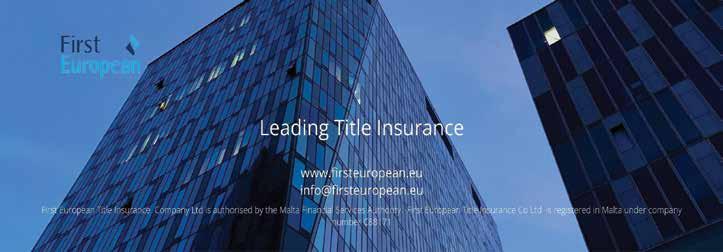
capital markets starting in 1990. Today, the group actively develops companies and projects, primarily in healthcare, financial services, retail, manufacturing, real estate and media. Having grown from a local to an international company, Penta now operates in more than ten markets across Europe. The name Penta is a tribute to the original five founding partners, all schoolmates during their studies in Moscow and Czechoslovakia.
Marek Dospiva follows a long line of regional and international luminaries to receive the accolade, from Cor Zadelhof, Eugene Golub and Carl Panattoni to Sandor Demjan, Pawel Debowski and Hadley Dean.
The integrity of the CEEQA judging process, from selection of the jury to the final results, is vital to the unique esteem and market value in which the awards are held. Each year, a panel of judges is selected from senior management representatives of market leading companies active in the sector who are charged with nominating candidates in 23 award categories, before inviting them to submit entry forms. The jury then assesses all the entries to decide on the short list and eventual winners through a rigorous procedure closely monitored by PwC.
14 CEEQA REPORT 2023 WARSAW BUSINESS JOURNAL LIFETIME ACHIEVEMENT/JURY
The Entries For The CEEQA Awards Are Judged By A Group Of The Most Experienced And Influential Operators Across The CEE And SEE Property Markets.
Untitled-2.indd 1 6/8/2022 8:16:55 PM
DON’T MISS THE PARTY!
Book Tickets Now. CEEQA Gala – June 14, Wyscigi Warsaw


The climax of the annual CEEQA awards, the annual gathering of leaders of the CEE & SEE commercial real estate market place is renowned for the elite level of guests and unparalleled networking, fine dining, world class entertainment and adventurous production. The CEEQA awards are completely free to enter, and they are the sector’s most trusted and valued industry awards and flagship annual gala.
Places at the CEEQA23 Gala are limited, book soon to avoid disappointment.

WARSAW BUSINESS JOURNAL CEEQA REPORT 2023 15
EVENT
SCAN TO BOOK NOW



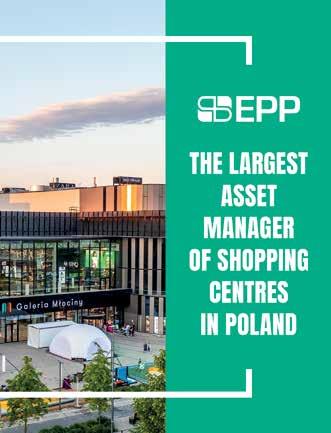
Specialised Insurance Solutions for Real Estate Contact us admin@REassurance.eu Real Estate Finance Banking Corporate Law Mergers & Acquisitions Litigations Anti-trust Real Estate Finance Banking Corporate Law Mergers & Acquisitions Litigations Anti-trust Real Estate Finance Banking Corporate Law Mergers & Acquisitions Litigations Anti-trust Real Estate Finance Banking Corporate Law Mergers & Acquisitions Litigations Anti-trust Real Estate Finance Banking Corporate Law Mergers & Acquisitions Litigations Anti-trust Real Estate Finance Banking Corporate Law Mergers & Acquisitions Litigations Anti-trust Real Estate Finance Banking Corporate Law Mergers & Acquisitions Litigations Anti-trust Real Estate Finance Banking Corporate Law Mergers & Acquisitions Litigations Anti-trust Real Estate Finance Banking Corporate Law Mergers & Acquisitions Litigations Anti-trust Real Estate Finance Banking Corporate Law Mergers & Acquisitions Litigations Anti-trust Real Estate Finance Banking Corporate Law Mergers & Acquisitions Litigations Anti-trust Real Estate Finance Banking Corporate Law Mergers & Acquisitions Litigations Anti-trust Real Estate Finance Banking Corporate Law Mergers & Acquisitions Litigations Anti-trust Real Estate Finance Banking Corporate Law Mergers & Acquisitions Litigations Anti-trust Real Estate Finance Banking Corporate Law Mergers & Acquisitions Litigations Anti-trust Real Estate Finance Banking Corporate Law Mergers & Acquisitions Litigations Anti-trust Real Estate Finance Banking Corporate Law Mergers & Acquisitions Litigations Anti-trust Real Estate Finance Banking Corporate Law Mergers & Acquisitions Litigations Anti-trust Real Estate Finance Banking Corporate Law Mergers & Acquisitions Litigations Anti-trust Real Estate Finance Banking Corporate Law Mergers & Acquisitions Litigations Anti-trust Real Estate Finance Banking Corporate Law Mergers & Acquisitions Litigations Anti-trust Real Estate Finance Banking Corporate Law Mergers & Acquisitions Litigations Anti-trust Real Estate Finance Banking Corporate Law Mergers & Acquisitions Litigations Anti-trust Real Estate Finance Banking Corporate Law Mergers & Acquisitions Litigations Anti-trustRealEstateFinance Banking Corporate Law Mergers & Acquisitions Litigations Anti-trust Real Estate Finance Banking Corporate Law Mergers & Acquisitions Litigations Anti-trust Real Estate Finance Banking Corporate Law Mergers & Acquisitions Litigations Anti-trust Real Estate Finance Banking Corporate Law Mergers & Acquisitions Litigations Anti-trust Real Estate Finance Banking Corporate Law Mergers & Acquisitions Litigations Anti-trust Real Estate Finance Banking Corporate Law Mergers & Acquisitions Litigations Anti-trust Real Estate Finance Banking Corporate Law Mergers & Acquisitions Litigations Anti-trust Real Estate Finance Banking Corporate Law Mergers & Acquisitions Litigations Anti-trust Real Estate Finance Banking Corporate Law Mergers & Acquisitions Litigations Anti-trust Real Estate Finance Banking Corporate Law Mergers & Acquisitions Litigations Anti-trust Real Estate Finance Banking Corporate Law Mergers & Acquisitions Litigations Anti-trust Real Estate Finance Banking Corporate Law Mergers & Acquisitions Litigations Anti-trust Real Estate Finance Banking Corporate Law Mergers & Acquisitions Litigations Anti-trust Real Estate Finance Banking Corporate Law Mergers & Acquisitions Litigations Anti-trust Real Estate Finance Banking Corporate Law Mergers & Acquisitions Litigations Anti-trust Real Estate Finance Banking Corporate Law Mergers & Acquisitions Litigations Anti-trust Real Estate Finance Banking Corporate Law Mergers & Acquisitions Litigations Anti-trust Real Estate Finance Banking Corporate Law Mergers & Acquisitions Litigations Anti-trust Real Estate Finance Banking Corporate Law Mergers & Acquisitions Litigations Anti-trust Real Estate Finance Banking Corporate Law Mergers & Acquisitions Litigations Anti-trust Real Estate Finance Banking Corporate Law Mergers & Acquisitions Litigations Anti-trust Real Estate Finance Banking Corporate Law Mergers & Acquisitions Litigations Anti-trust Real Estate Finance Banking Corporate Law Mergers & Acquisitions Litigations Anti-trust Real Estate Finance Banking Corporate Law Mergers & Acquisitions Litigations Anti-trust Real Estate Finance Banking Corporate Law Mergers Wilsons A leading independent CEE law firm Untitled-2 1 08.06.2022 22:58

































































 BY SEAN REYNAUD
BY SEAN REYNAUD


 BY SEAN REYNAUD
BY SEAN REYNAUD





 BY SEAN REYNAUD
BY SEAN REYNAUD















































